Financial Accounting
VerifiedAdded on 2022/11/24
|28
|4585
|487
AI Summary
This document provides an introduction to financial accounting, including its purpose and goals. It covers different types of business transactions, calculation methods, the difference between financial statements and financial reports, principles of accounting, and a cash flow statement. The document also includes a profit and loss account and balance sheet.
Contribute Materials
Your contribution can guide someone’s learning journey. Share your
documents today.

Financial Accounting
Secure Best Marks with AI Grader
Need help grading? Try our AI Grader for instant feedback on your assignments.

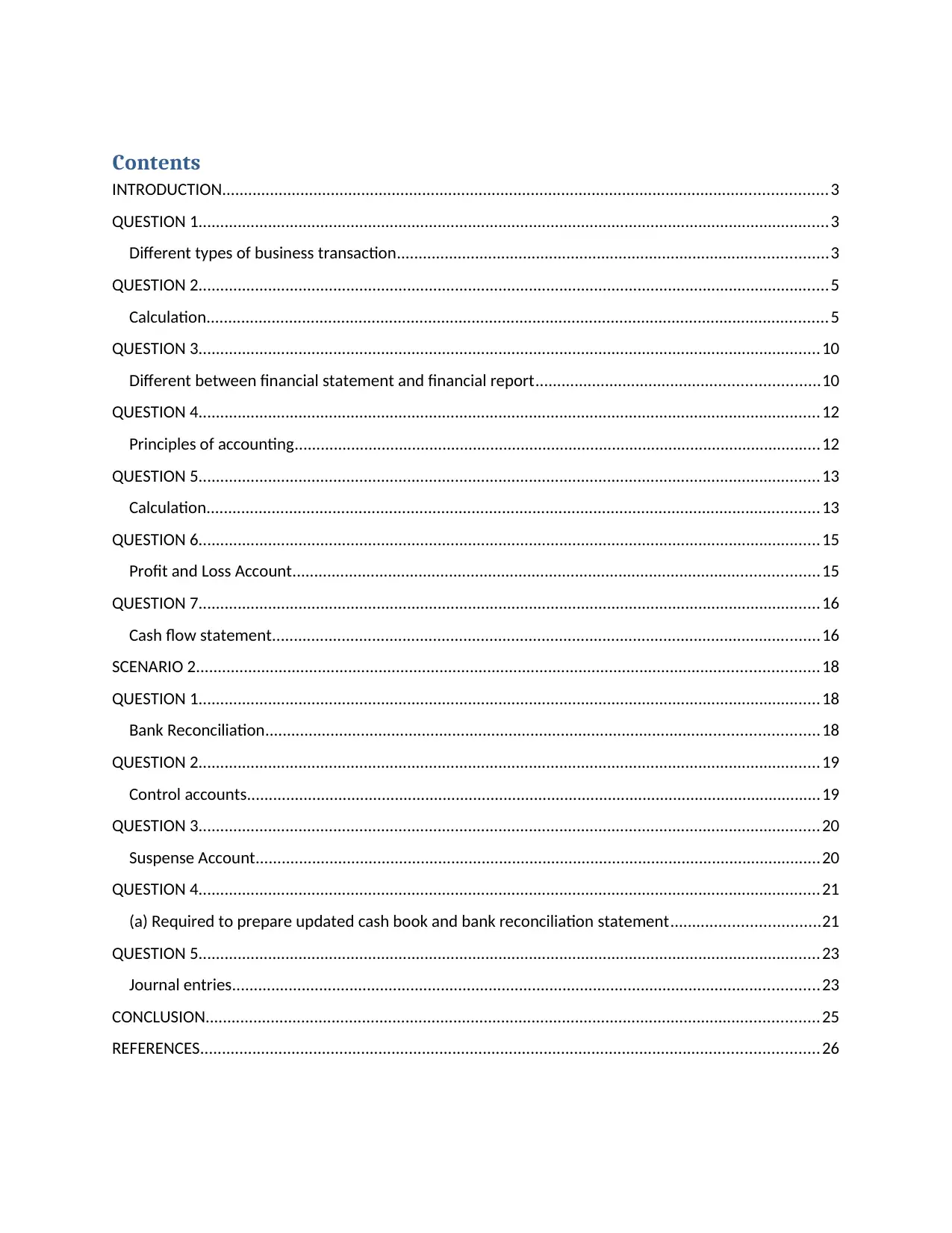
Contents
INTRODUCTION...........................................................................................................................................3
QUESTION 1.................................................................................................................................................3
Different types of business transaction...................................................................................................3
QUESTION 2.................................................................................................................................................5
Calculation...............................................................................................................................................5
QUESTION 3...............................................................................................................................................10
Different between financial statement and financial report.................................................................10
QUESTION 4...............................................................................................................................................12
Principles of accounting.........................................................................................................................12
QUESTION 5...............................................................................................................................................13
Calculation.............................................................................................................................................13
QUESTION 6...............................................................................................................................................15
Profit and Loss Account.........................................................................................................................15
QUESTION 7...............................................................................................................................................16
Cash flow statement..............................................................................................................................16
SCENARIO 2...............................................................................................................................................18
QUESTION 1...............................................................................................................................................18
Bank Reconciliation...............................................................................................................................18
QUESTION 2...............................................................................................................................................19
Control accounts....................................................................................................................................19
QUESTION 3...............................................................................................................................................20
Suspense Account..................................................................................................................................20
QUESTION 4...............................................................................................................................................21
(a) Required to prepare updated cash book and bank reconciliation statement..................................21
QUESTION 5...............................................................................................................................................23
Journal entries.......................................................................................................................................23
CONCLUSION.............................................................................................................................................25
REFERENCES..............................................................................................................................................26
INTRODUCTION...........................................................................................................................................3
QUESTION 1.................................................................................................................................................3
Different types of business transaction...................................................................................................3
QUESTION 2.................................................................................................................................................5
Calculation...............................................................................................................................................5
QUESTION 3...............................................................................................................................................10
Different between financial statement and financial report.................................................................10
QUESTION 4...............................................................................................................................................12
Principles of accounting.........................................................................................................................12
QUESTION 5...............................................................................................................................................13
Calculation.............................................................................................................................................13
QUESTION 6...............................................................................................................................................15
Profit and Loss Account.........................................................................................................................15
QUESTION 7...............................................................................................................................................16
Cash flow statement..............................................................................................................................16
SCENARIO 2...............................................................................................................................................18
QUESTION 1...............................................................................................................................................18
Bank Reconciliation...............................................................................................................................18
QUESTION 2...............................................................................................................................................19
Control accounts....................................................................................................................................19
QUESTION 3...............................................................................................................................................20
Suspense Account..................................................................................................................................20
QUESTION 4...............................................................................................................................................21
(a) Required to prepare updated cash book and bank reconciliation statement..................................21
QUESTION 5...............................................................................................................................................23
Journal entries.......................................................................................................................................23
CONCLUSION.............................................................................................................................................25
REFERENCES..............................................................................................................................................26
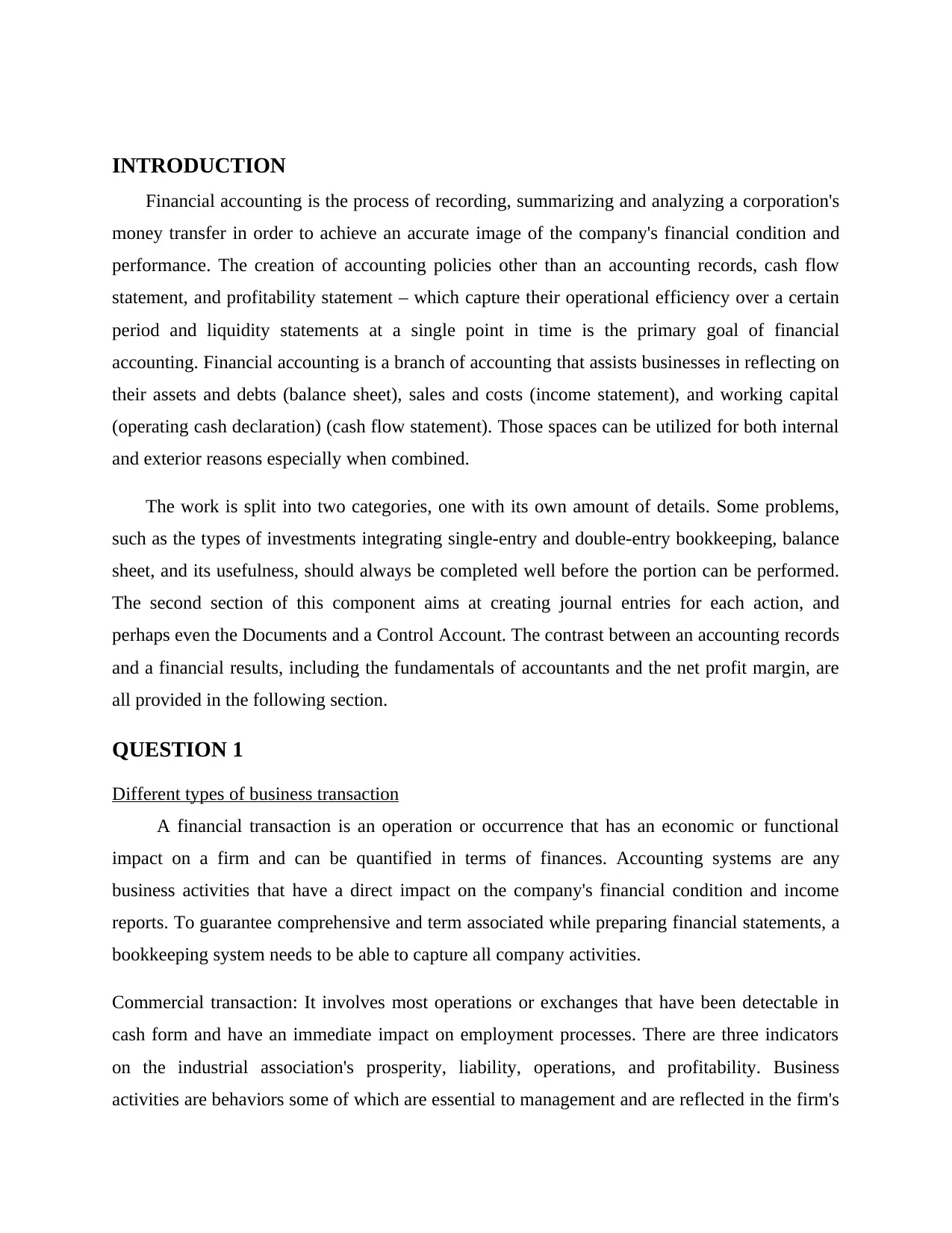
INTRODUCTION
Financial accounting is the process of recording, summarizing and analyzing a corporation's
money transfer in order to achieve an accurate image of the company's financial condition and
performance. The creation of accounting policies other than an accounting records, cash flow
statement, and profitability statement – which capture their operational efficiency over a certain
period and liquidity statements at a single point in time is the primary goal of financial
accounting. Financial accounting is a branch of accounting that assists businesses in reflecting on
their assets and debts (balance sheet), sales and costs (income statement), and working capital
(operating cash declaration) (cash flow statement). Those spaces can be utilized for both internal
and exterior reasons especially when combined.
The work is split into two categories, one with its own amount of details. Some problems,
such as the types of investments integrating single-entry and double-entry bookkeeping, balance
sheet, and its usefulness, should always be completed well before the portion can be performed.
The second section of this component aims at creating journal entries for each action, and
perhaps even the Documents and a Control Account. The contrast between an accounting records
and a financial results, including the fundamentals of accountants and the net profit margin, are
all provided in the following section.
QUESTION 1
Different types of business transaction
A financial transaction is an operation or occurrence that has an economic or functional
impact on a firm and can be quantified in terms of finances. Accounting systems are any
business activities that have a direct impact on the company's financial condition and income
reports. To guarantee comprehensive and term associated while preparing financial statements, a
bookkeeping system needs to be able to capture all company activities.
Commercial transaction: It involves most operations or exchanges that have been detectable in
cash form and have an immediate impact on employment processes. There are three indicators
on the industrial association's prosperity, liability, operations, and profitability. Business
activities are behaviors some of which are essential to management and are reflected in the firm's
Financial accounting is the process of recording, summarizing and analyzing a corporation's
money transfer in order to achieve an accurate image of the company's financial condition and
performance. The creation of accounting policies other than an accounting records, cash flow
statement, and profitability statement – which capture their operational efficiency over a certain
period and liquidity statements at a single point in time is the primary goal of financial
accounting. Financial accounting is a branch of accounting that assists businesses in reflecting on
their assets and debts (balance sheet), sales and costs (income statement), and working capital
(operating cash declaration) (cash flow statement). Those spaces can be utilized for both internal
and exterior reasons especially when combined.
The work is split into two categories, one with its own amount of details. Some problems,
such as the types of investments integrating single-entry and double-entry bookkeeping, balance
sheet, and its usefulness, should always be completed well before the portion can be performed.
The second section of this component aims at creating journal entries for each action, and
perhaps even the Documents and a Control Account. The contrast between an accounting records
and a financial results, including the fundamentals of accountants and the net profit margin, are
all provided in the following section.
QUESTION 1
Different types of business transaction
A financial transaction is an operation or occurrence that has an economic or functional
impact on a firm and can be quantified in terms of finances. Accounting systems are any
business activities that have a direct impact on the company's financial condition and income
reports. To guarantee comprehensive and term associated while preparing financial statements, a
bookkeeping system needs to be able to capture all company activities.
Commercial transaction: It involves most operations or exchanges that have been detectable in
cash form and have an immediate impact on employment processes. There are three indicators
on the industrial association's prosperity, liability, operations, and profitability. Business
activities are behaviors some of which are essential to management and are reflected in the firm's
Secure Best Marks with AI Grader
Need help grading? Try our AI Grader for instant feedback on your assignments.
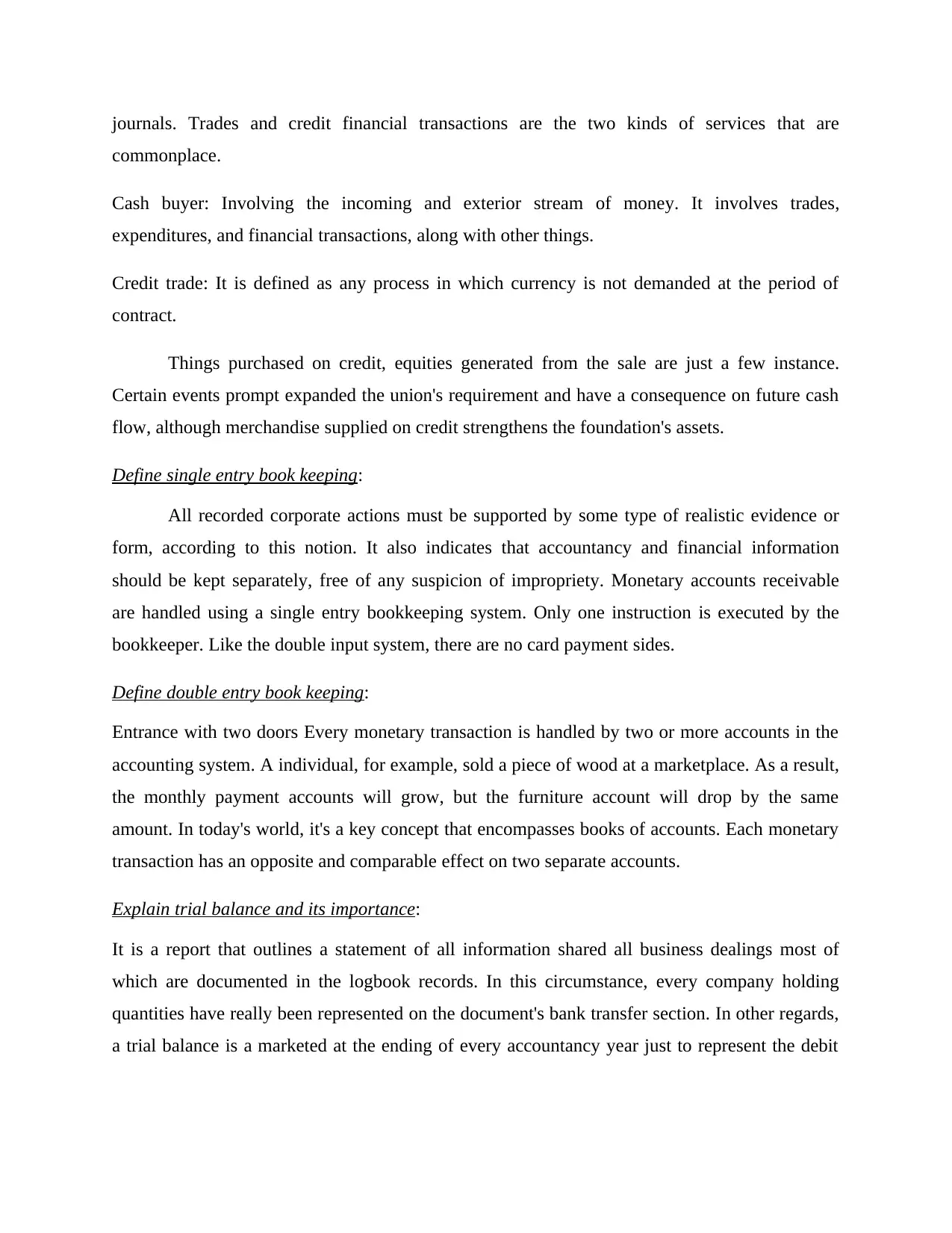
journals. Trades and credit financial transactions are the two kinds of services that are
commonplace.
Cash buyer: Involving the incoming and exterior stream of money. It involves trades,
expenditures, and financial transactions, along with other things.
Credit trade: It is defined as any process in which currency is not demanded at the period of
contract.
Things purchased on credit, equities generated from the sale are just a few instance.
Certain events prompt expanded the union's requirement and have a consequence on future cash
flow, although merchandise supplied on credit strengthens the foundation's assets.
Define single entry book keeping:
All recorded corporate actions must be supported by some type of realistic evidence or
form, according to this notion. It also indicates that accountancy and financial information
should be kept separately, free of any suspicion of impropriety. Monetary accounts receivable
are handled using a single entry bookkeeping system. Only one instruction is executed by the
bookkeeper. Like the double input system, there are no card payment sides.
Define double entry book keeping:
Entrance with two doors Every monetary transaction is handled by two or more accounts in the
accounting system. A individual, for example, sold a piece of wood at a marketplace. As a result,
the monthly payment accounts will grow, but the furniture account will drop by the same
amount. In today's world, it's a key concept that encompasses books of accounts. Each monetary
transaction has an opposite and comparable effect on two separate accounts.
Explain trial balance and its importance:
It is a report that outlines a statement of all information shared all business dealings most of
which are documented in the logbook records. In this circumstance, every company holding
quantities have really been represented on the document's bank transfer section. In other regards,
a trial balance is a marketed at the ending of every accountancy year just to represent the debit
commonplace.
Cash buyer: Involving the incoming and exterior stream of money. It involves trades,
expenditures, and financial transactions, along with other things.
Credit trade: It is defined as any process in which currency is not demanded at the period of
contract.
Things purchased on credit, equities generated from the sale are just a few instance.
Certain events prompt expanded the union's requirement and have a consequence on future cash
flow, although merchandise supplied on credit strengthens the foundation's assets.
Define single entry book keeping:
All recorded corporate actions must be supported by some type of realistic evidence or
form, according to this notion. It also indicates that accountancy and financial information
should be kept separately, free of any suspicion of impropriety. Monetary accounts receivable
are handled using a single entry bookkeeping system. Only one instruction is executed by the
bookkeeper. Like the double input system, there are no card payment sides.
Define double entry book keeping:
Entrance with two doors Every monetary transaction is handled by two or more accounts in the
accounting system. A individual, for example, sold a piece of wood at a marketplace. As a result,
the monthly payment accounts will grow, but the furniture account will drop by the same
amount. In today's world, it's a key concept that encompasses books of accounts. Each monetary
transaction has an opposite and comparable effect on two separate accounts.
Explain trial balance and its importance:
It is a report that outlines a statement of all information shared all business dealings most of
which are documented in the logbook records. In this circumstance, every company holding
quantities have really been represented on the document's bank transfer section. In other regards,
a trial balance is a marketed at the ending of every accountancy year just to represent the debit
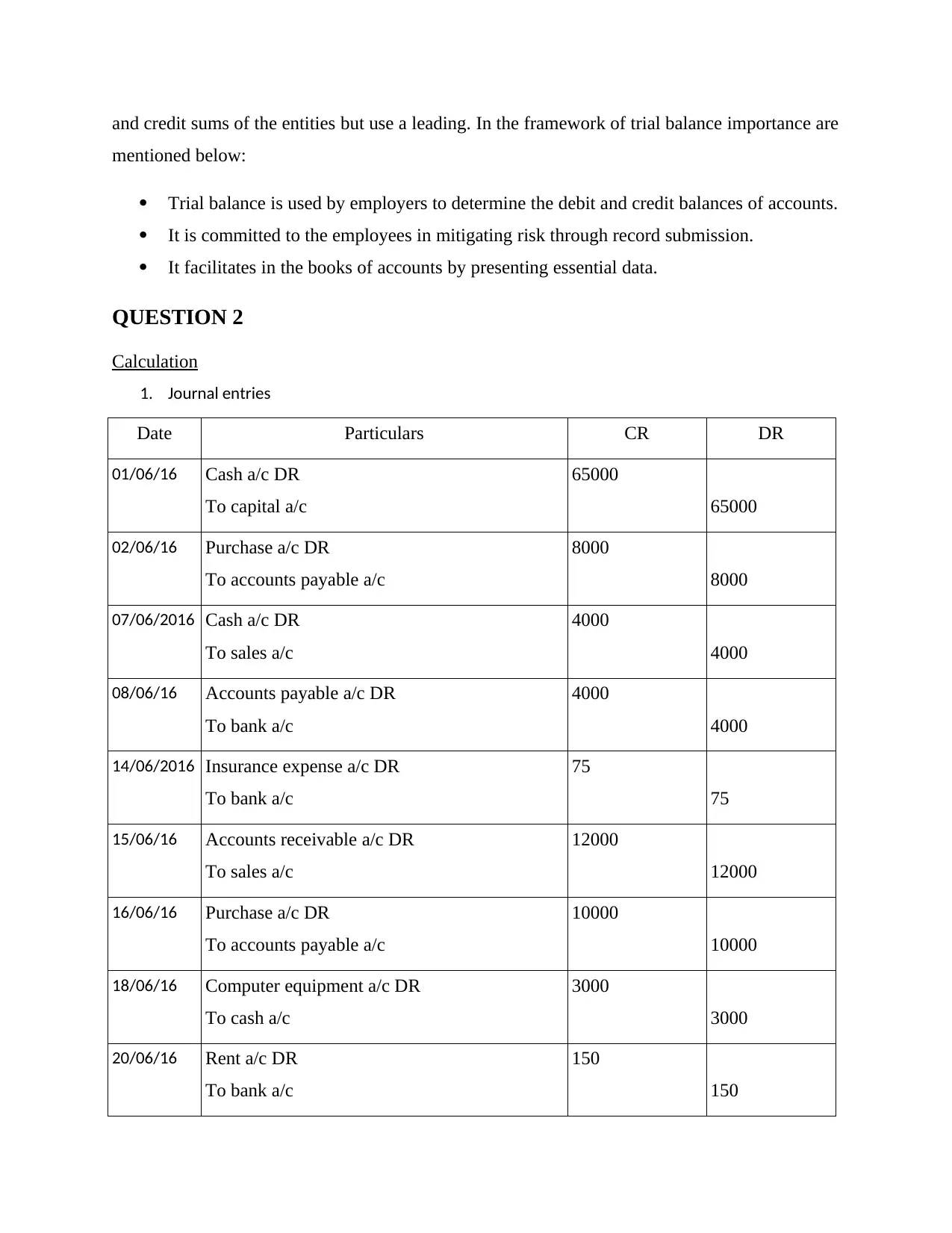
and credit sums of the entities but use a leading. In the framework of trial balance importance are
mentioned below:
Trial balance is used by employers to determine the debit and credit balances of accounts.
It is committed to the employees in mitigating risk through record submission.
It facilitates in the books of accounts by presenting essential data.
QUESTION 2
Calculation
1. Journal entries
Date Particulars CR DR
01/06/16 Cash a/c DR
To capital a/c
65000
65000
02/06/16 Purchase a/c DR
To accounts payable a/c
8000
8000
07/06/2016 Cash a/c DR
To sales a/c
4000
4000
08/06/16 Accounts payable a/c DR
To bank a/c
4000
4000
14/06/2016 Insurance expense a/c DR
To bank a/c
75
75
15/06/16 Accounts receivable a/c DR
To sales a/c
12000
12000
16/06/16 Purchase a/c DR
To accounts payable a/c
10000
10000
18/06/16 Computer equipment a/c DR
To cash a/c
3000
3000
20/06/16 Rent a/c DR
To bank a/c
150
150
mentioned below:
Trial balance is used by employers to determine the debit and credit balances of accounts.
It is committed to the employees in mitigating risk through record submission.
It facilitates in the books of accounts by presenting essential data.
QUESTION 2
Calculation
1. Journal entries
Date Particulars CR DR
01/06/16 Cash a/c DR
To capital a/c
65000
65000
02/06/16 Purchase a/c DR
To accounts payable a/c
8000
8000
07/06/2016 Cash a/c DR
To sales a/c
4000
4000
08/06/16 Accounts payable a/c DR
To bank a/c
4000
4000
14/06/2016 Insurance expense a/c DR
To bank a/c
75
75
15/06/16 Accounts receivable a/c DR
To sales a/c
12000
12000
16/06/16 Purchase a/c DR
To accounts payable a/c
10000
10000
18/06/16 Computer equipment a/c DR
To cash a/c
3000
3000
20/06/16 Rent a/c DR
To bank a/c
150
150
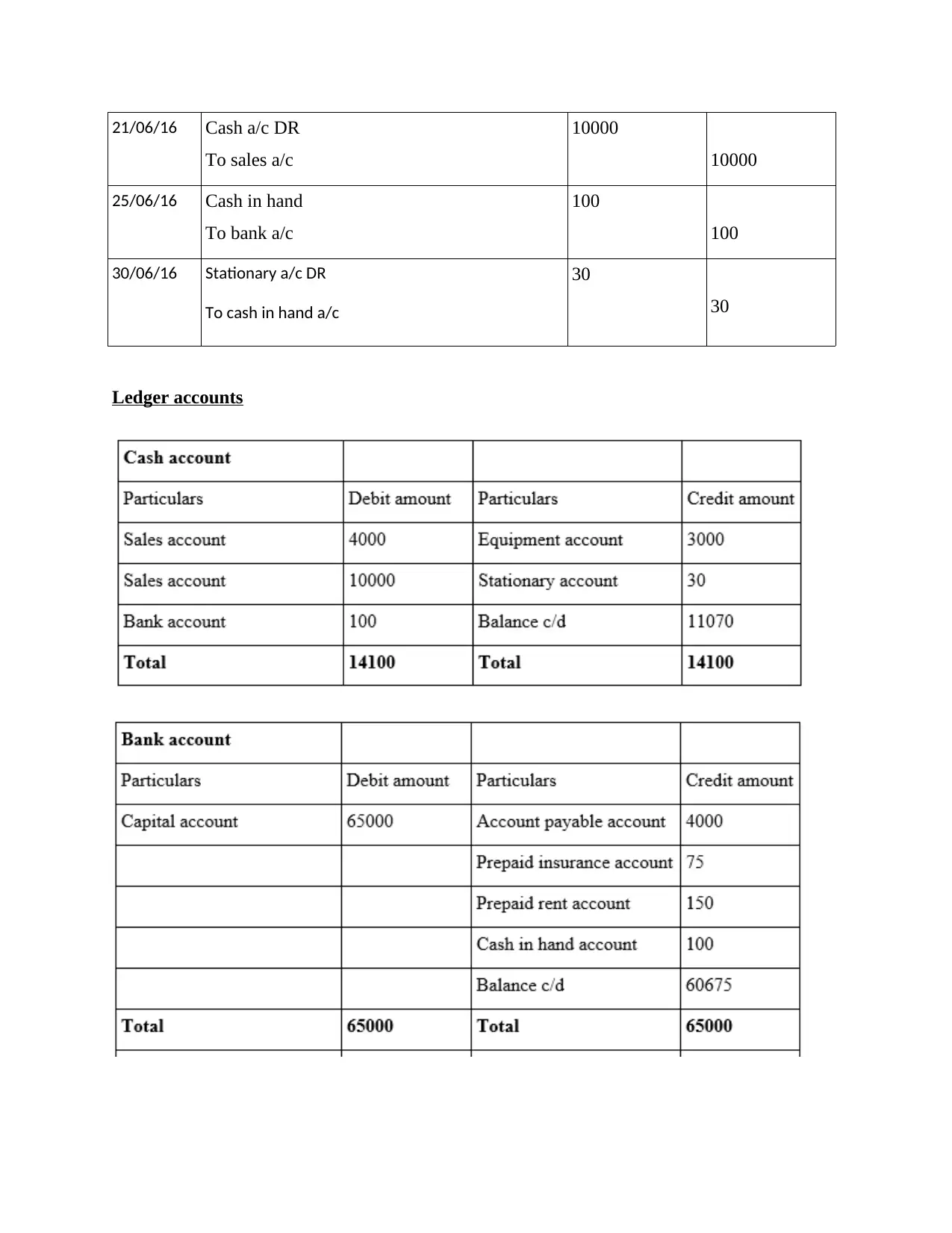
21/06/16 Cash a/c DR
To sales a/c
10000
10000
25/06/16 Cash in hand
To bank a/c
100
100
30/06/16 Stationary a/c DR
To cash in hand a/c
30
30
Ledger accounts
To sales a/c
10000
10000
25/06/16 Cash in hand
To bank a/c
100
100
30/06/16 Stationary a/c DR
To cash in hand a/c
30
30
Ledger accounts
Paraphrase This Document
Need a fresh take? Get an instant paraphrase of this document with our AI Paraphraser
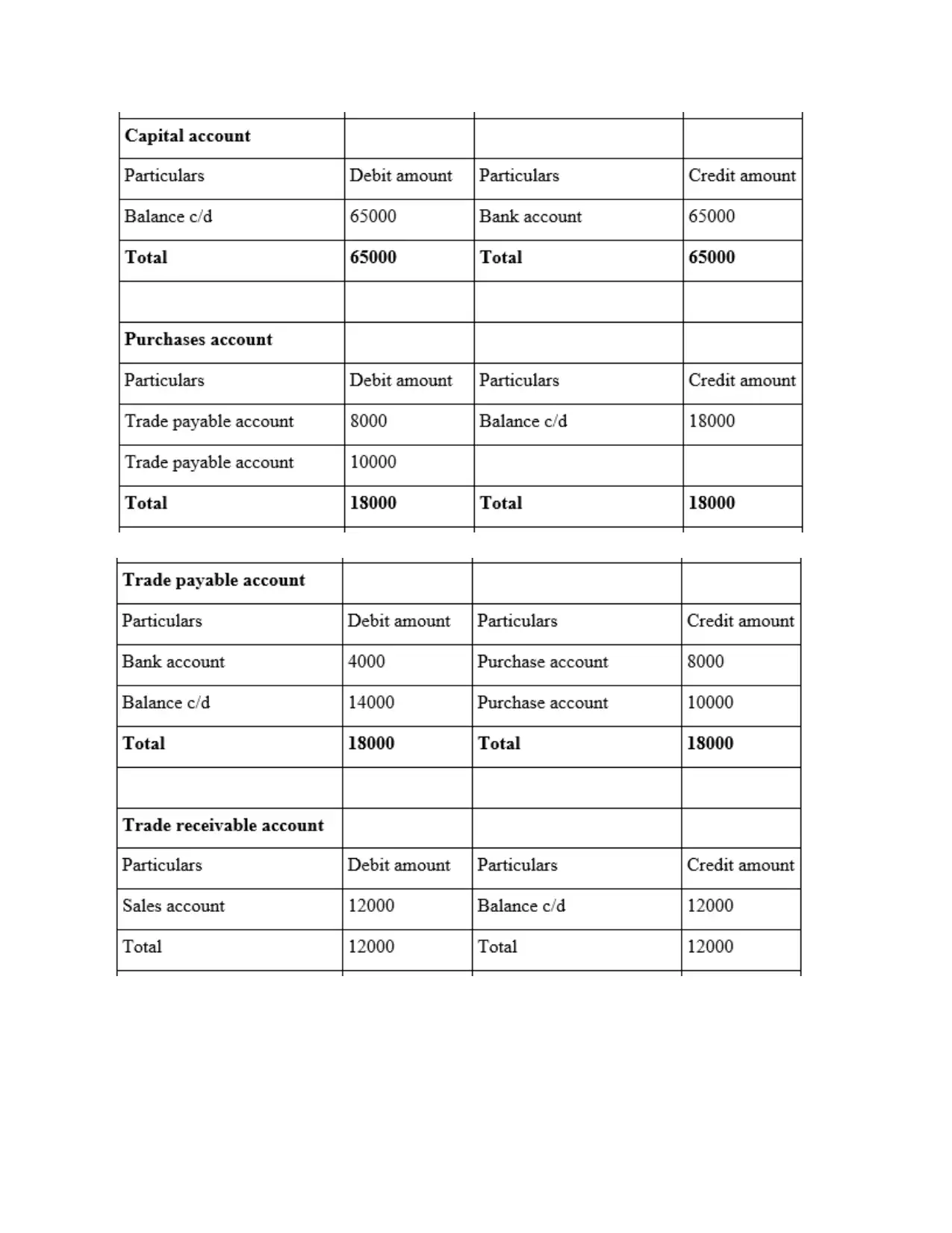
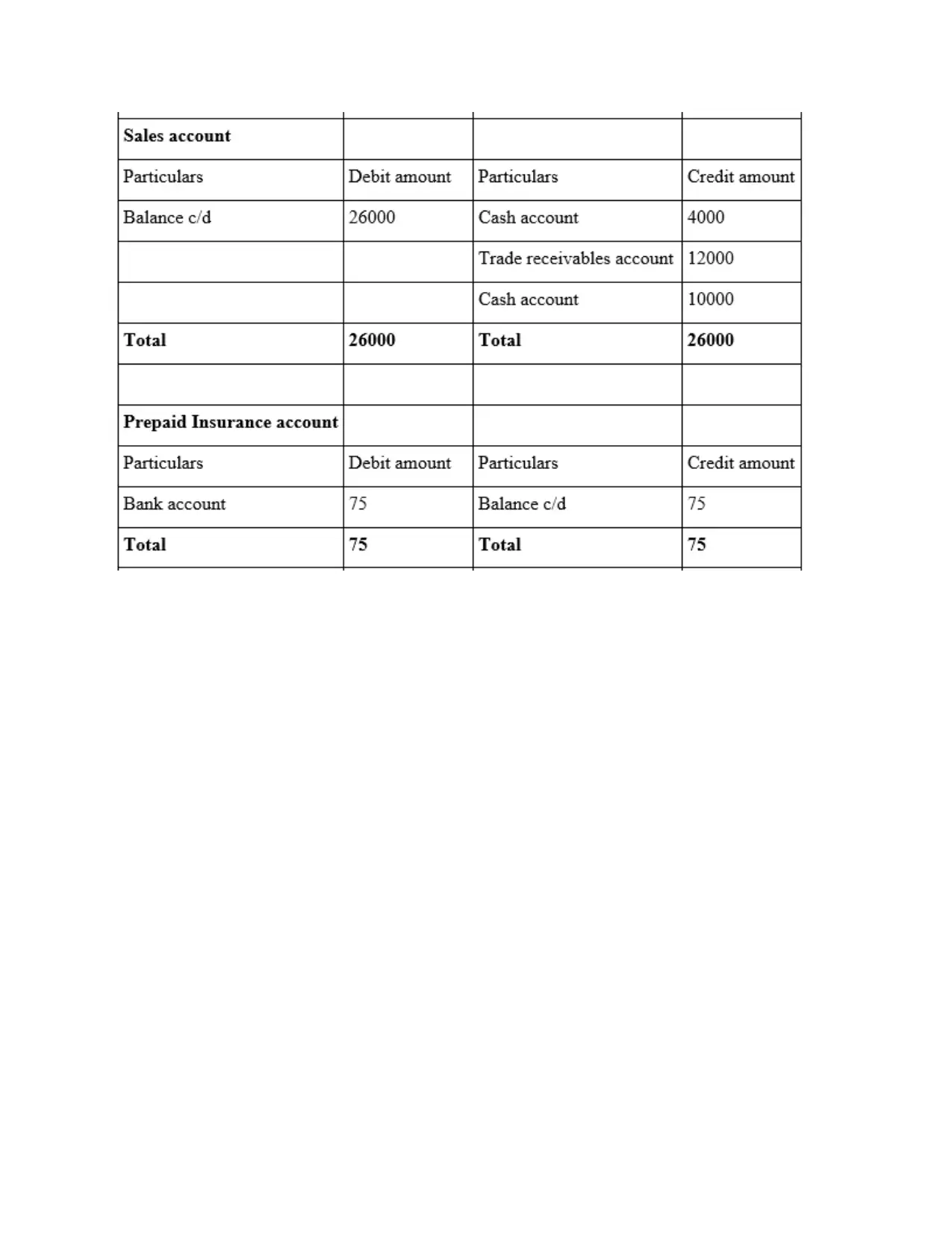
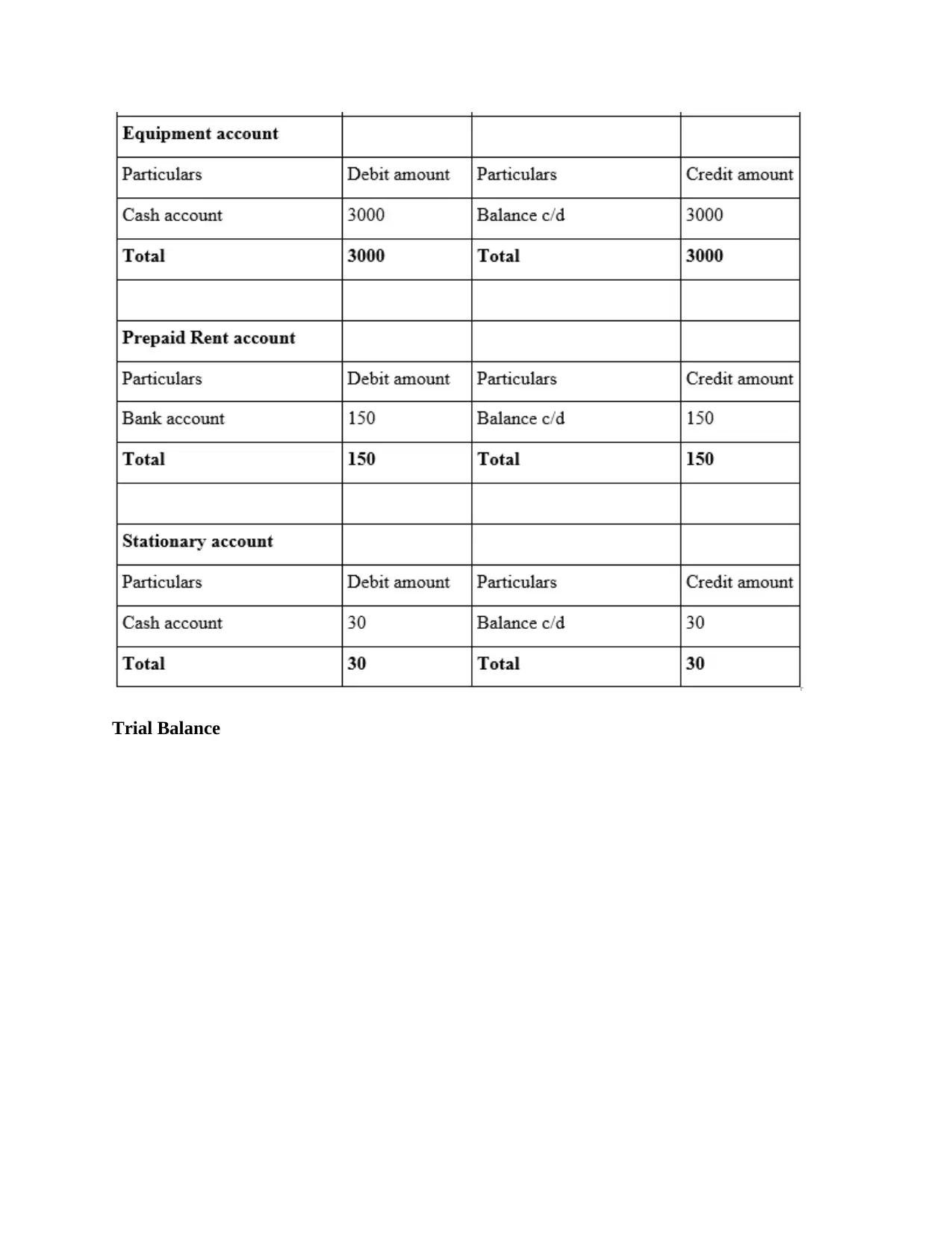
Trial Balance
Secure Best Marks with AI Grader
Need help grading? Try our AI Grader for instant feedback on your assignments.
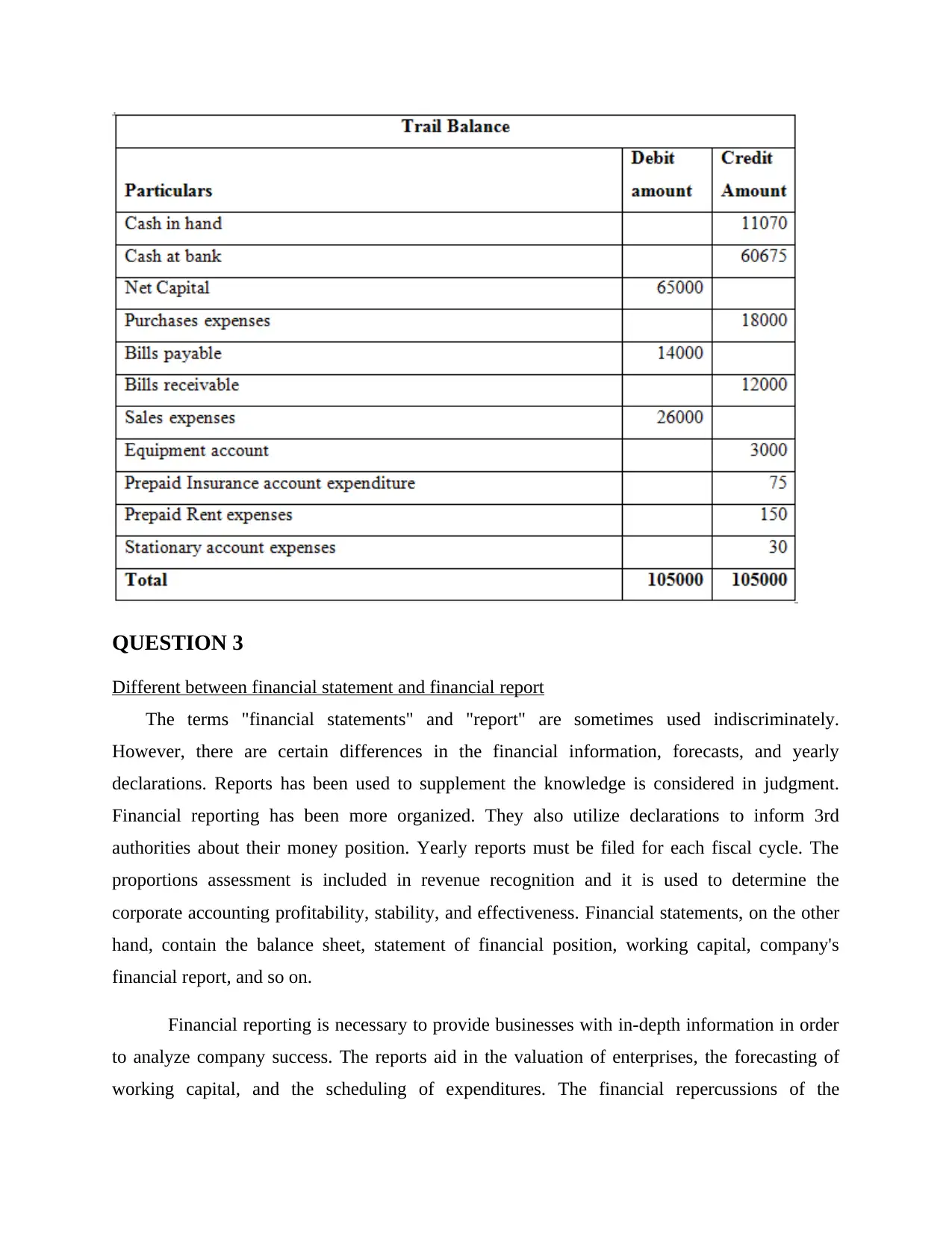
QUESTION 3
Different between financial statement and financial report
The terms "financial statements" and "report" are sometimes used indiscriminately.
However, there are certain differences in the financial information, forecasts, and yearly
declarations. Reports has been used to supplement the knowledge is considered in judgment.
Financial reporting has been more organized. They also utilize declarations to inform 3rd
authorities about their money position. Yearly reports must be filed for each fiscal cycle. The
proportions assessment is included in revenue recognition and it is used to determine the
corporate accounting profitability, stability, and effectiveness. Financial statements, on the other
hand, contain the balance sheet, statement of financial position, working capital, company's
financial report, and so on.
Financial reporting is necessary to provide businesses with in-depth information in order
to analyze company success. The reports aid in the valuation of enterprises, the forecasting of
working capital, and the scheduling of expenditures. The financial repercussions of the
Different between financial statement and financial report
The terms "financial statements" and "report" are sometimes used indiscriminately.
However, there are certain differences in the financial information, forecasts, and yearly
declarations. Reports has been used to supplement the knowledge is considered in judgment.
Financial reporting has been more organized. They also utilize declarations to inform 3rd
authorities about their money position. Yearly reports must be filed for each fiscal cycle. The
proportions assessment is included in revenue recognition and it is used to determine the
corporate accounting profitability, stability, and effectiveness. Financial statements, on the other
hand, contain the balance sheet, statement of financial position, working capital, company's
financial report, and so on.
Financial reporting is necessary to provide businesses with in-depth information in order
to analyze company success. The reports aid in the valuation of enterprises, the forecasting of
working capital, and the scheduling of expenditures. The financial repercussions of the
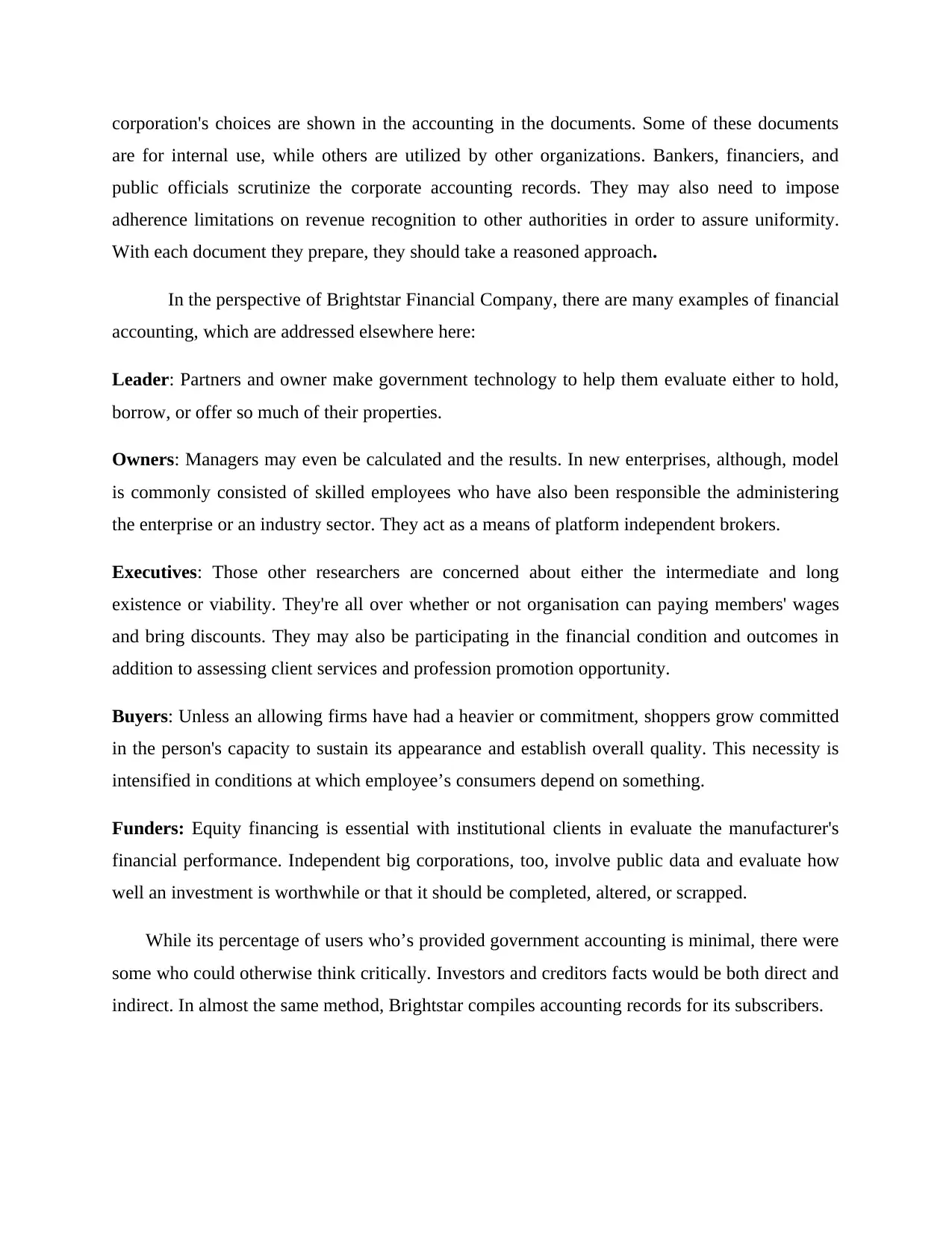
corporation's choices are shown in the accounting in the documents. Some of these documents
are for internal use, while others are utilized by other organizations. Bankers, financiers, and
public officials scrutinize the corporate accounting records. They may also need to impose
adherence limitations on revenue recognition to other authorities in order to assure uniformity.
With each document they prepare, they should take a reasoned approach.
In the perspective of Brightstar Financial Company, there are many examples of financial
accounting, which are addressed elsewhere here:
Leader: Partners and owner make government technology to help them evaluate either to hold,
borrow, or offer so much of their properties.
Owners: Managers may even be calculated and the results. In new enterprises, although, model
is commonly consisted of skilled employees who have also been responsible the administering
the enterprise or an industry sector. They act as a means of platform independent brokers.
Executives: Those other researchers are concerned about either the intermediate and long
existence or viability. They're all over whether or not organisation can paying members' wages
and bring discounts. They may also be participating in the financial condition and outcomes in
addition to assessing client services and profession promotion opportunity.
Buyers: Unless an allowing firms have had a heavier or commitment, shoppers grow committed
in the person's capacity to sustain its appearance and establish overall quality. This necessity is
intensified in conditions at which employee’s consumers depend on something.
Funders: Equity financing is essential with institutional clients in evaluate the manufacturer's
financial performance. Independent big corporations, too, involve public data and evaluate how
well an investment is worthwhile or that it should be completed, altered, or scrapped.
While its percentage of users who’s provided government accounting is minimal, there were
some who could otherwise think critically. Investors and creditors facts would be both direct and
indirect. In almost the same method, Brightstar compiles accounting records for its subscribers.
are for internal use, while others are utilized by other organizations. Bankers, financiers, and
public officials scrutinize the corporate accounting records. They may also need to impose
adherence limitations on revenue recognition to other authorities in order to assure uniformity.
With each document they prepare, they should take a reasoned approach.
In the perspective of Brightstar Financial Company, there are many examples of financial
accounting, which are addressed elsewhere here:
Leader: Partners and owner make government technology to help them evaluate either to hold,
borrow, or offer so much of their properties.
Owners: Managers may even be calculated and the results. In new enterprises, although, model
is commonly consisted of skilled employees who have also been responsible the administering
the enterprise or an industry sector. They act as a means of platform independent brokers.
Executives: Those other researchers are concerned about either the intermediate and long
existence or viability. They're all over whether or not organisation can paying members' wages
and bring discounts. They may also be participating in the financial condition and outcomes in
addition to assessing client services and profession promotion opportunity.
Buyers: Unless an allowing firms have had a heavier or commitment, shoppers grow committed
in the person's capacity to sustain its appearance and establish overall quality. This necessity is
intensified in conditions at which employee’s consumers depend on something.
Funders: Equity financing is essential with institutional clients in evaluate the manufacturer's
financial performance. Independent big corporations, too, involve public data and evaluate how
well an investment is worthwhile or that it should be completed, altered, or scrapped.
While its percentage of users who’s provided government accounting is minimal, there were
some who could otherwise think critically. Investors and creditors facts would be both direct and
indirect. In almost the same method, Brightstar compiles accounting records for its subscribers.
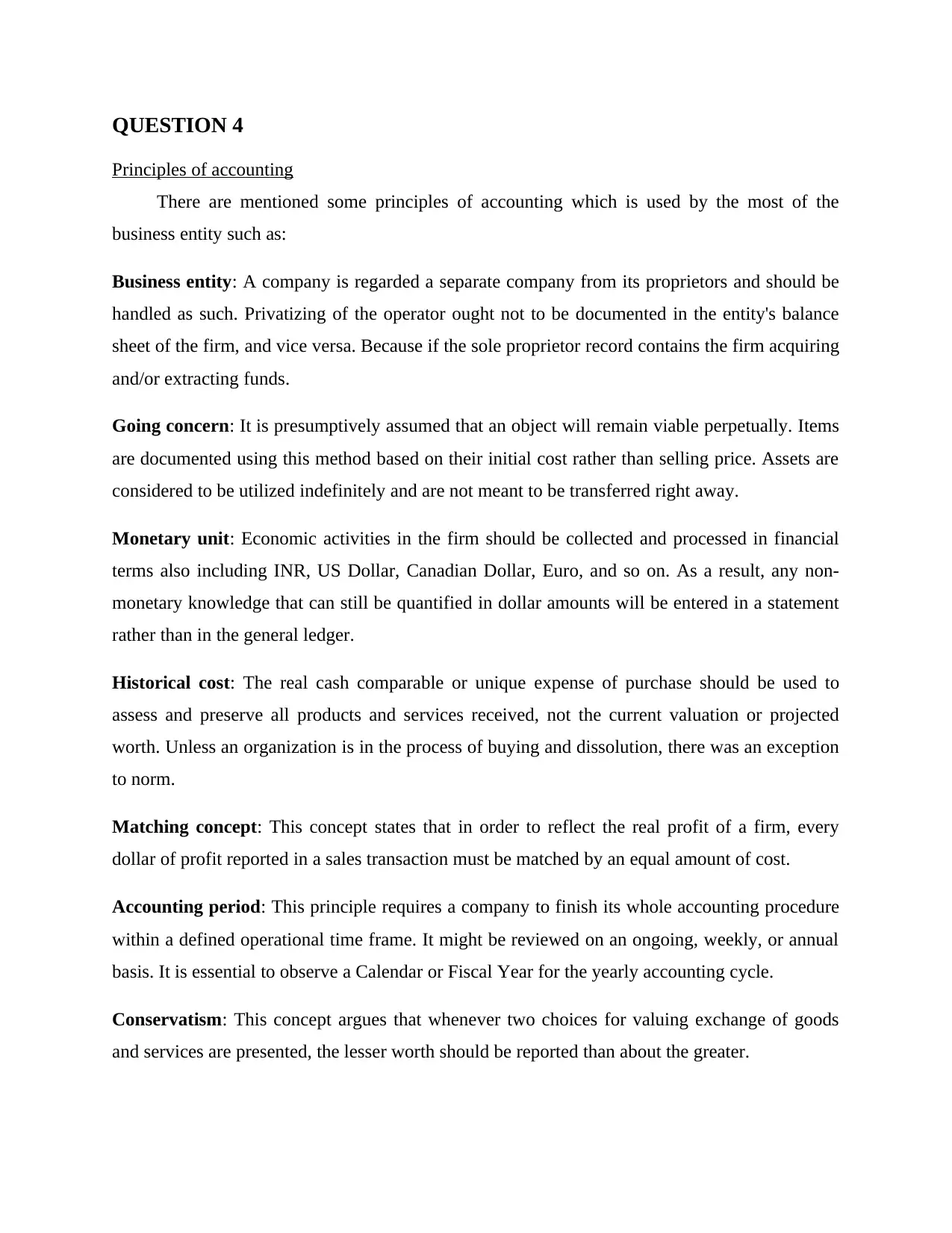
QUESTION 4
Principles of accounting
There are mentioned some principles of accounting which is used by the most of the
business entity such as:
Business entity: A company is regarded a separate company from its proprietors and should be
handled as such. Privatizing of the operator ought not to be documented in the entity's balance
sheet of the firm, and vice versa. Because if the sole proprietor record contains the firm acquiring
and/or extracting funds.
Going concern: It is presumptively assumed that an object will remain viable perpetually. Items
are documented using this method based on their initial cost rather than selling price. Assets are
considered to be utilized indefinitely and are not meant to be transferred right away.
Monetary unit: Economic activities in the firm should be collected and processed in financial
terms also including INR, US Dollar, Canadian Dollar, Euro, and so on. As a result, any non-
monetary knowledge that can still be quantified in dollar amounts will be entered in a statement
rather than in the general ledger.
Historical cost: The real cash comparable or unique expense of purchase should be used to
assess and preserve all products and services received, not the current valuation or projected
worth. Unless an organization is in the process of buying and dissolution, there was an exception
to norm.
Matching concept: This concept states that in order to reflect the real profit of a firm, every
dollar of profit reported in a sales transaction must be matched by an equal amount of cost.
Accounting period: This principle requires a company to finish its whole accounting procedure
within a defined operational time frame. It might be reviewed on an ongoing, weekly, or annual
basis. It is essential to observe a Calendar or Fiscal Year for the yearly accounting cycle.
Conservatism: This concept argues that whenever two choices for valuing exchange of goods
and services are presented, the lesser worth should be reported than about the greater.
Principles of accounting
There are mentioned some principles of accounting which is used by the most of the
business entity such as:
Business entity: A company is regarded a separate company from its proprietors and should be
handled as such. Privatizing of the operator ought not to be documented in the entity's balance
sheet of the firm, and vice versa. Because if the sole proprietor record contains the firm acquiring
and/or extracting funds.
Going concern: It is presumptively assumed that an object will remain viable perpetually. Items
are documented using this method based on their initial cost rather than selling price. Assets are
considered to be utilized indefinitely and are not meant to be transferred right away.
Monetary unit: Economic activities in the firm should be collected and processed in financial
terms also including INR, US Dollar, Canadian Dollar, Euro, and so on. As a result, any non-
monetary knowledge that can still be quantified in dollar amounts will be entered in a statement
rather than in the general ledger.
Historical cost: The real cash comparable or unique expense of purchase should be used to
assess and preserve all products and services received, not the current valuation or projected
worth. Unless an organization is in the process of buying and dissolution, there was an exception
to norm.
Matching concept: This concept states that in order to reflect the real profit of a firm, every
dollar of profit reported in a sales transaction must be matched by an equal amount of cost.
Accounting period: This principle requires a company to finish its whole accounting procedure
within a defined operational time frame. It might be reviewed on an ongoing, weekly, or annual
basis. It is essential to observe a Calendar or Fiscal Year for the yearly accounting cycle.
Conservatism: This concept argues that whenever two choices for valuing exchange of goods
and services are presented, the lesser worth should be reported than about the greater.
Paraphrase This Document
Need a fresh take? Get an instant paraphrase of this document with our AI Paraphraser
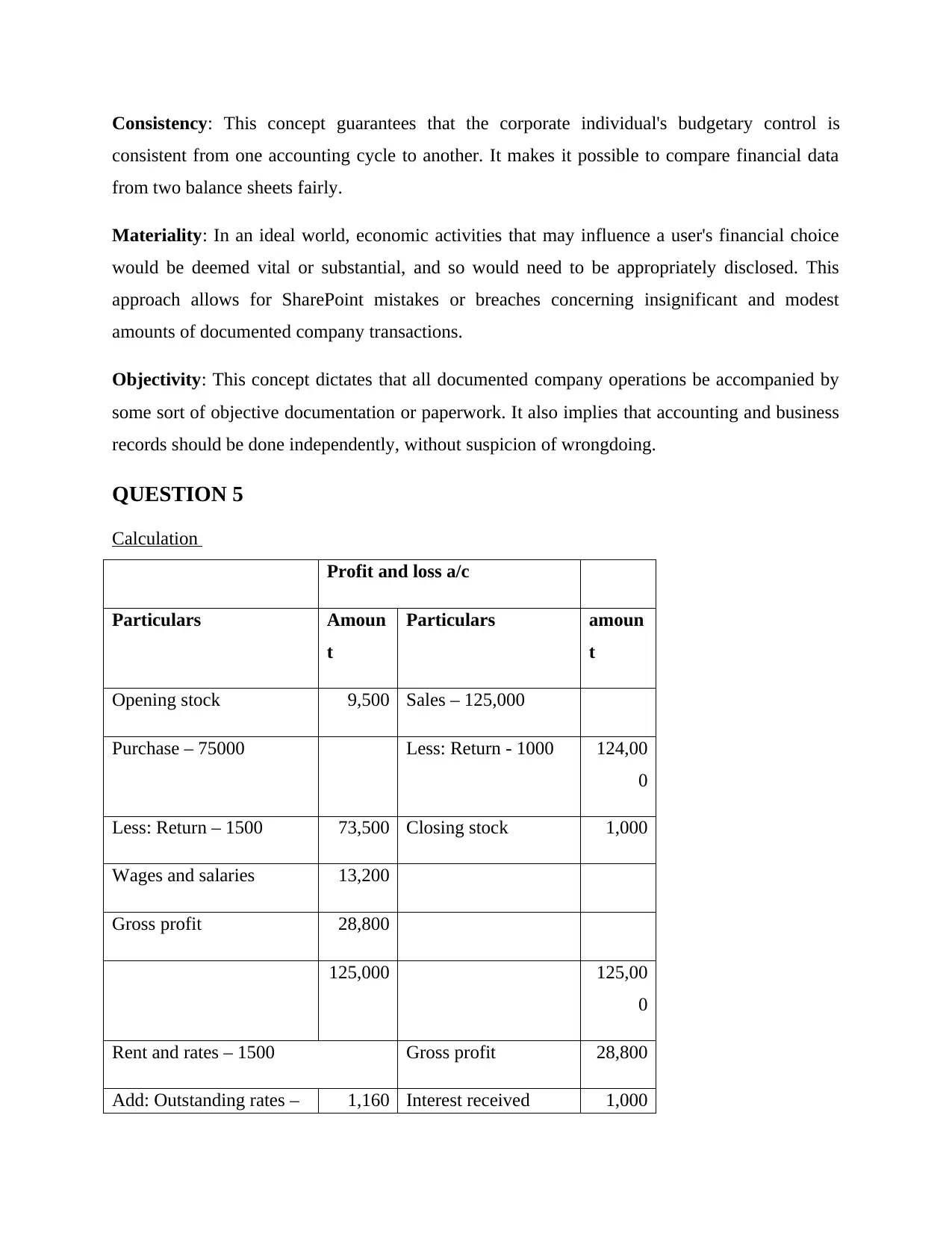
Consistency: This concept guarantees that the corporate individual's budgetary control is
consistent from one accounting cycle to another. It makes it possible to compare financial data
from two balance sheets fairly.
Materiality: In an ideal world, economic activities that may influence a user's financial choice
would be deemed vital or substantial, and so would need to be appropriately disclosed. This
approach allows for SharePoint mistakes or breaches concerning insignificant and modest
amounts of documented company transactions.
Objectivity: This concept dictates that all documented company operations be accompanied by
some sort of objective documentation or paperwork. It also implies that accounting and business
records should be done independently, without suspicion of wrongdoing.
QUESTION 5
Calculation
Profit and loss a/c
Particulars Amoun
t
Particulars amoun
t
Opening stock 9,500 Sales – 125,000
Purchase – 75000 Less: Return - 1000 124,00
0
Less: Return – 1500 73,500 Closing stock 1,000
Wages and salaries 13,200
Gross profit 28,800
125,000 125,00
0
Rent and rates – 1500 Gross profit 28,800
Add: Outstanding rates – 1,160 Interest received 1,000
consistent from one accounting cycle to another. It makes it possible to compare financial data
from two balance sheets fairly.
Materiality: In an ideal world, economic activities that may influence a user's financial choice
would be deemed vital or substantial, and so would need to be appropriately disclosed. This
approach allows for SharePoint mistakes or breaches concerning insignificant and modest
amounts of documented company transactions.
Objectivity: This concept dictates that all documented company operations be accompanied by
some sort of objective documentation or paperwork. It also implies that accounting and business
records should be done independently, without suspicion of wrongdoing.
QUESTION 5
Calculation
Profit and loss a/c
Particulars Amoun
t
Particulars amoun
t
Opening stock 9,500 Sales – 125,000
Purchase – 75000 Less: Return - 1000 124,00
0
Less: Return – 1500 73,500 Closing stock 1,000
Wages and salaries 13,200
Gross profit 28,800
125,000 125,00
0
Rent and rates – 1500 Gross profit 28,800
Add: Outstanding rates – 1,160 Interest received 1,000
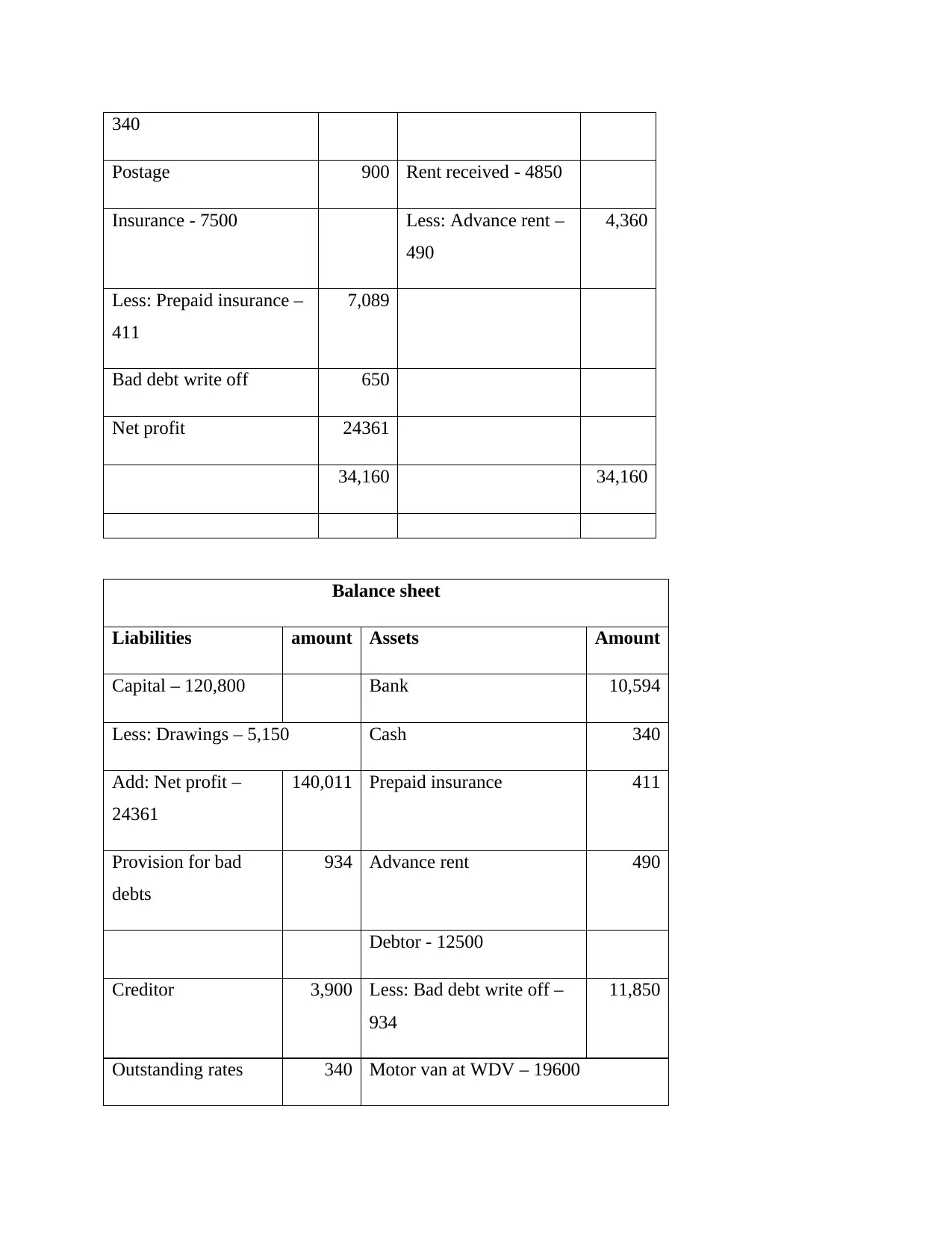
340
Postage 900 Rent received - 4850
Insurance - 7500 Less: Advance rent –
490
4,360
Less: Prepaid insurance –
411
7,089
Bad debt write off 650
Net profit 24361
34,160 34,160
Balance sheet
Liabilities amount Assets Amount
Capital – 120,800 Bank 10,594
Less: Drawings – 5,150 Cash 340
Add: Net profit –
24361
140,011 Prepaid insurance 411
Provision for bad
debts
934 Advance rent 490
Debtor - 12500
Creditor 3,900 Less: Bad debt write off –
934
11,850
Outstanding rates 340 Motor van at WDV – 19600
Postage 900 Rent received - 4850
Insurance - 7500 Less: Advance rent –
490
4,360
Less: Prepaid insurance –
411
7,089
Bad debt write off 650
Net profit 24361
34,160 34,160
Balance sheet
Liabilities amount Assets Amount
Capital – 120,800 Bank 10,594
Less: Drawings – 5,150 Cash 340
Add: Net profit –
24361
140,011 Prepaid insurance 411
Provision for bad
debts
934 Advance rent 490
Debtor - 12500
Creditor 3,900 Less: Bad debt write off –
934
11,850
Outstanding rates 340 Motor van at WDV – 19600
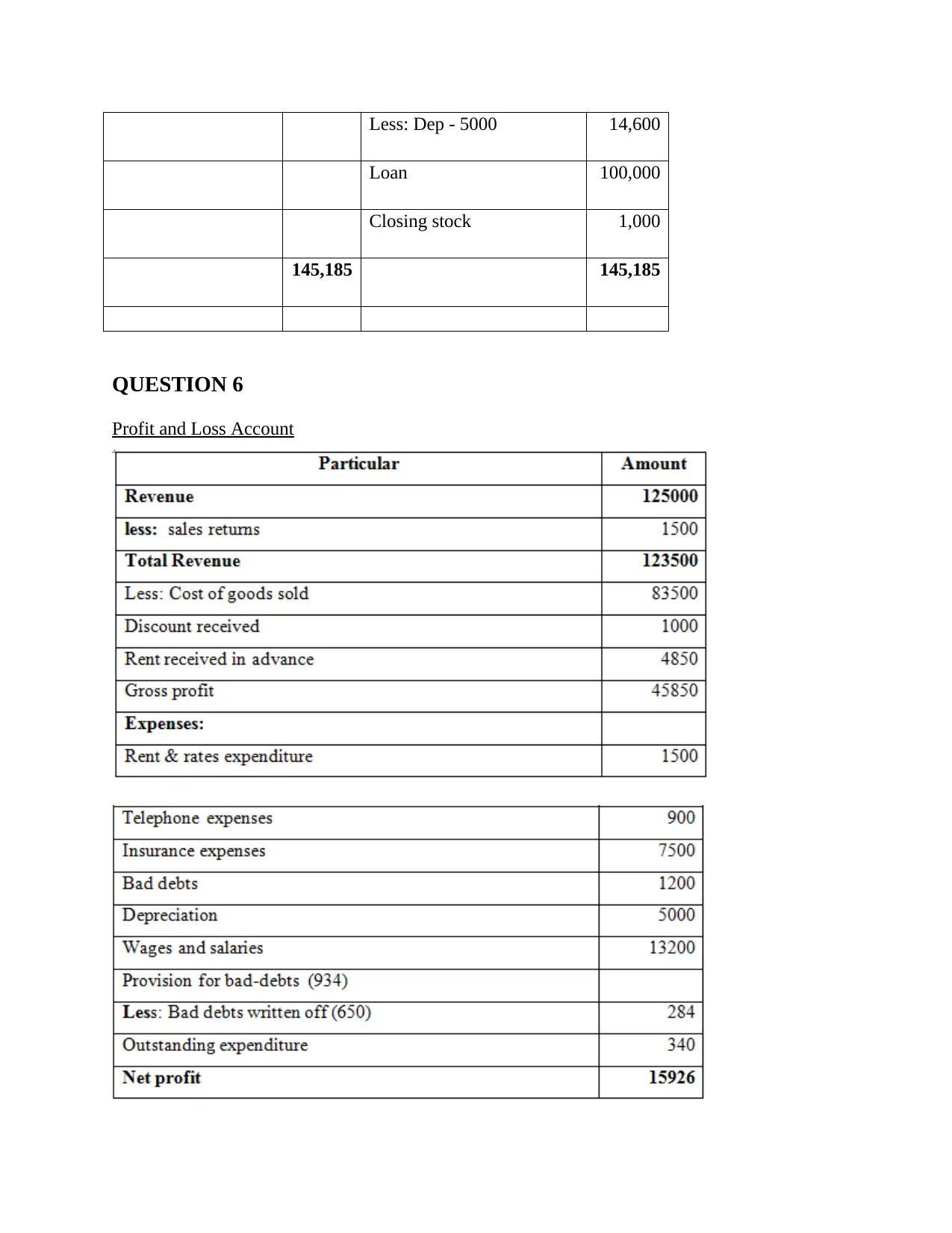
Less: Dep - 5000 14,600
Loan 100,000
Closing stock 1,000
145,185 145,185
QUESTION 6
Profit and Loss Account
Loan 100,000
Closing stock 1,000
145,185 145,185
QUESTION 6
Profit and Loss Account
Secure Best Marks with AI Grader
Need help grading? Try our AI Grader for instant feedback on your assignments.
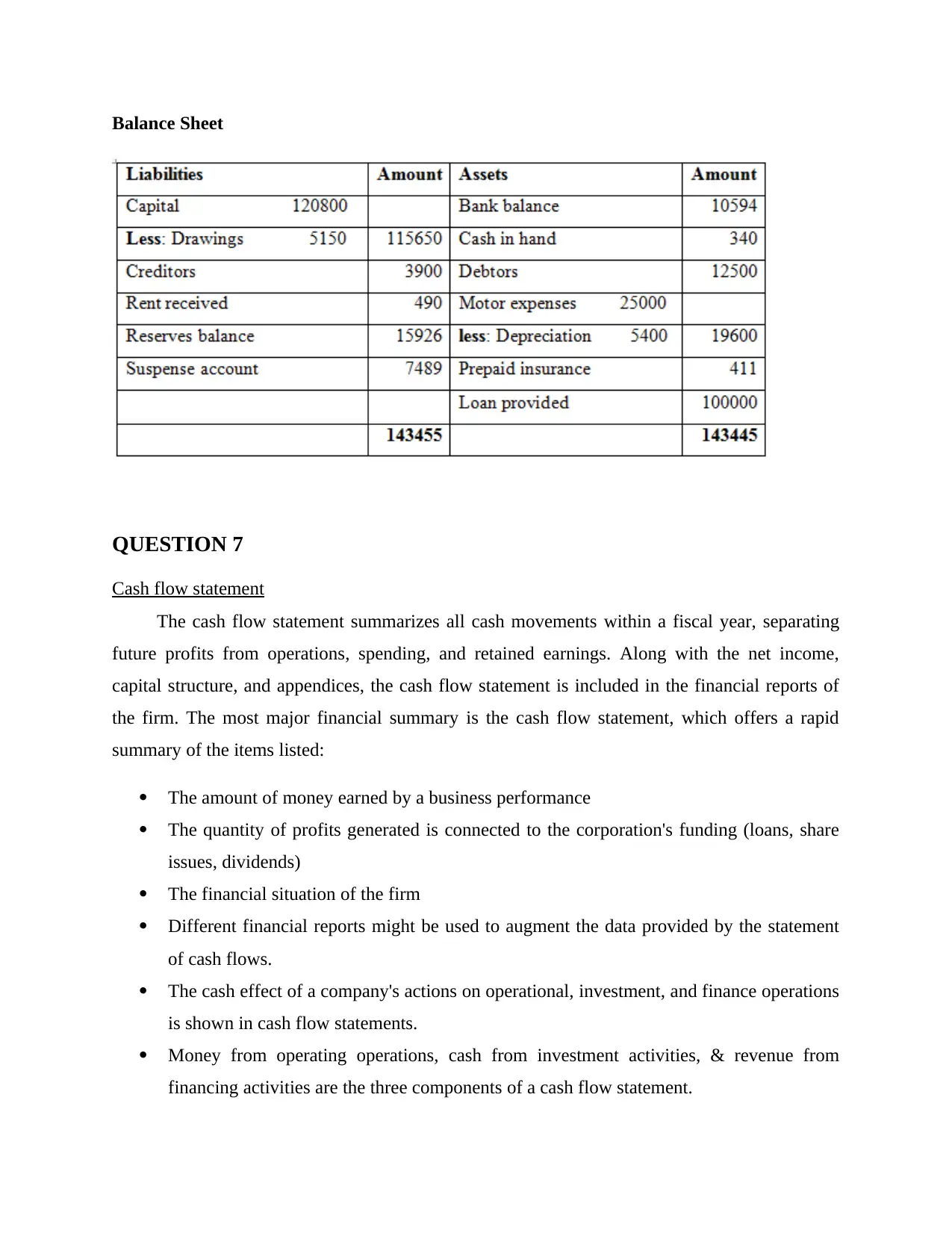
Balance Sheet
QUESTION 7
Cash flow statement
The cash flow statement summarizes all cash movements within a fiscal year, separating
future profits from operations, spending, and retained earnings. Along with the net income,
capital structure, and appendices, the cash flow statement is included in the financial reports of
the firm. The most major financial summary is the cash flow statement, which offers a rapid
summary of the items listed:
The amount of money earned by a business performance
The quantity of profits generated is connected to the corporation's funding (loans, share
issues, dividends)
The financial situation of the firm
Different financial reports might be used to augment the data provided by the statement
of cash flows.
The cash effect of a company's actions on operational, investment, and finance operations
is shown in cash flow statements.
Money from operating operations, cash from investment activities, & revenue from
financing activities are the three components of a cash flow statement.
QUESTION 7
Cash flow statement
The cash flow statement summarizes all cash movements within a fiscal year, separating
future profits from operations, spending, and retained earnings. Along with the net income,
capital structure, and appendices, the cash flow statement is included in the financial reports of
the firm. The most major financial summary is the cash flow statement, which offers a rapid
summary of the items listed:
The amount of money earned by a business performance
The quantity of profits generated is connected to the corporation's funding (loans, share
issues, dividends)
The financial situation of the firm
Different financial reports might be used to augment the data provided by the statement
of cash flows.
The cash effect of a company's actions on operational, investment, and finance operations
is shown in cash flow statements.
Money from operating operations, cash from investment activities, & revenue from
financing activities are the three components of a cash flow statement.
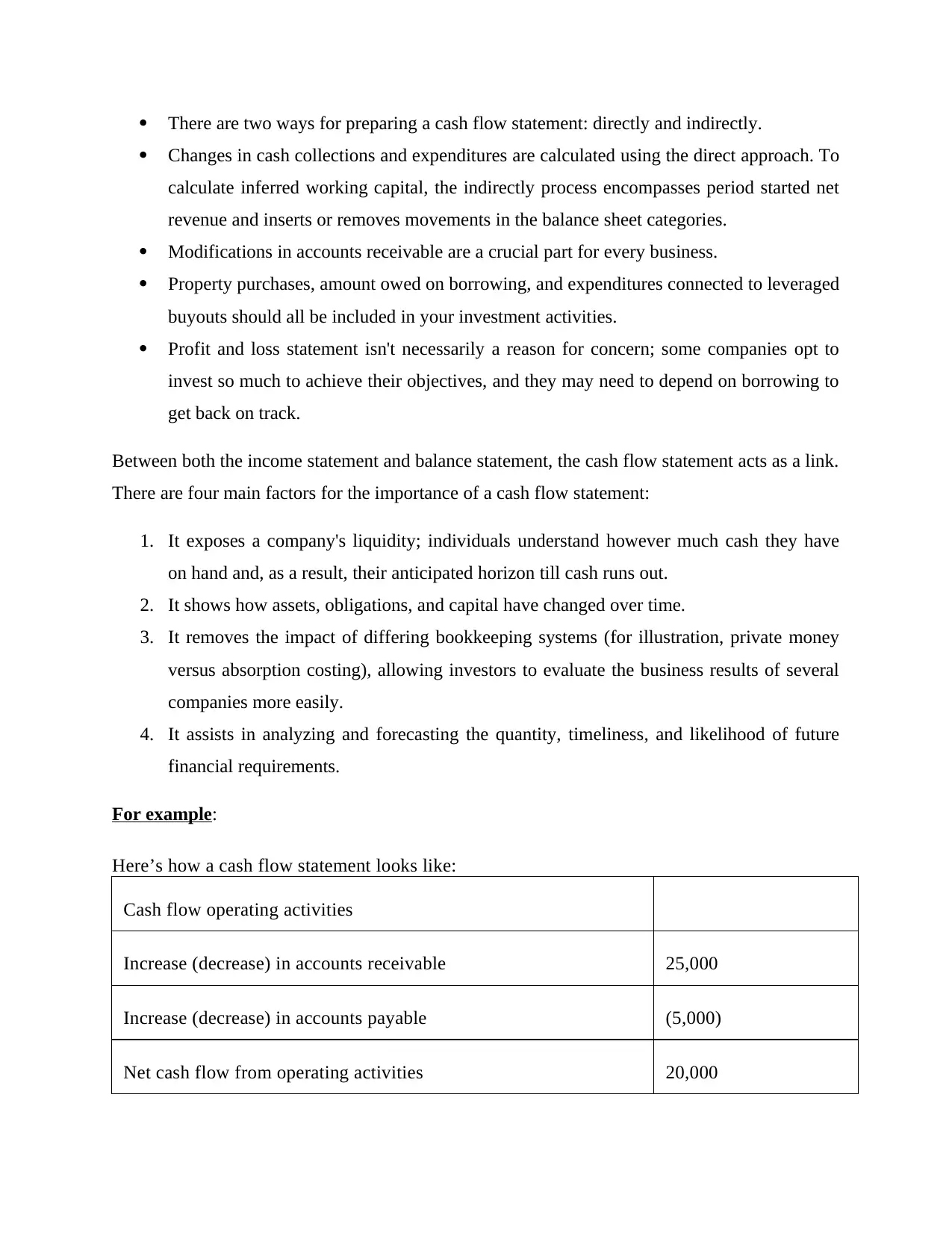
There are two ways for preparing a cash flow statement: directly and indirectly.
Changes in cash collections and expenditures are calculated using the direct approach. To
calculate inferred working capital, the indirectly process encompasses period started net
revenue and inserts or removes movements in the balance sheet categories.
Modifications in accounts receivable are a crucial part for every business.
Property purchases, amount owed on borrowing, and expenditures connected to leveraged
buyouts should all be included in your investment activities.
Profit and loss statement isn't necessarily a reason for concern; some companies opt to
invest so much to achieve their objectives, and they may need to depend on borrowing to
get back on track.
Between both the income statement and balance statement, the cash flow statement acts as a link.
There are four main factors for the importance of a cash flow statement:
1. It exposes a company's liquidity; individuals understand however much cash they have
on hand and, as a result, their anticipated horizon till cash runs out.
2. It shows how assets, obligations, and capital have changed over time.
3. It removes the impact of differing bookkeeping systems (for illustration, private money
versus absorption costing), allowing investors to evaluate the business results of several
companies more easily.
4. It assists in analyzing and forecasting the quantity, timeliness, and likelihood of future
financial requirements.
For example:
Here’s how a cash flow statement looks like:
Cash flow operating activities
Increase (decrease) in accounts receivable 25,000
Increase (decrease) in accounts payable (5,000)
Net cash flow from operating activities 20,000
Changes in cash collections and expenditures are calculated using the direct approach. To
calculate inferred working capital, the indirectly process encompasses period started net
revenue and inserts or removes movements in the balance sheet categories.
Modifications in accounts receivable are a crucial part for every business.
Property purchases, amount owed on borrowing, and expenditures connected to leveraged
buyouts should all be included in your investment activities.
Profit and loss statement isn't necessarily a reason for concern; some companies opt to
invest so much to achieve their objectives, and they may need to depend on borrowing to
get back on track.
Between both the income statement and balance statement, the cash flow statement acts as a link.
There are four main factors for the importance of a cash flow statement:
1. It exposes a company's liquidity; individuals understand however much cash they have
on hand and, as a result, their anticipated horizon till cash runs out.
2. It shows how assets, obligations, and capital have changed over time.
3. It removes the impact of differing bookkeeping systems (for illustration, private money
versus absorption costing), allowing investors to evaluate the business results of several
companies more easily.
4. It assists in analyzing and forecasting the quantity, timeliness, and likelihood of future
financial requirements.
For example:
Here’s how a cash flow statement looks like:
Cash flow operating activities
Increase (decrease) in accounts receivable 25,000
Increase (decrease) in accounts payable (5,000)
Net cash flow from operating activities 20,000
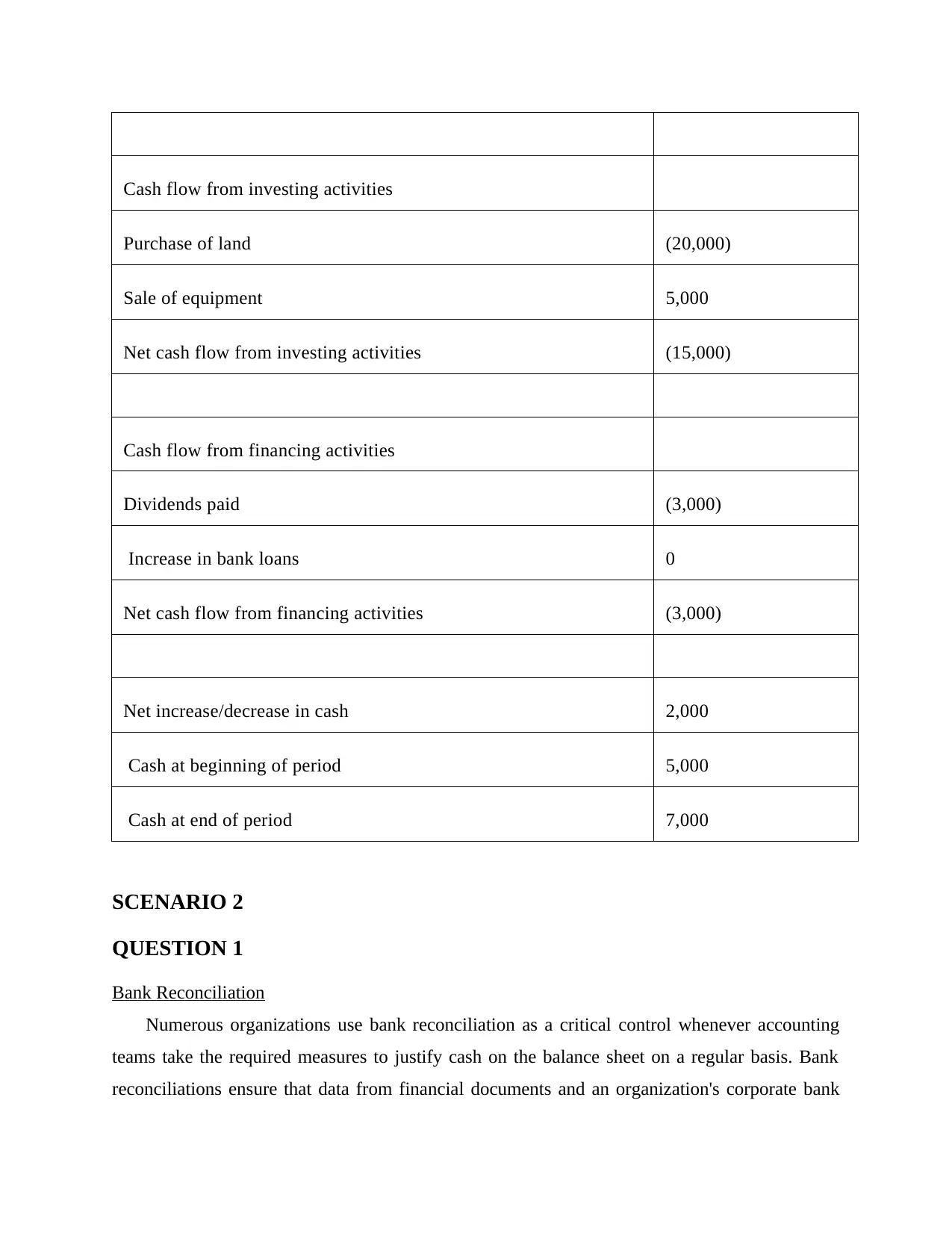
Cash flow from investing activities
Purchase of land (20,000)
Sale of equipment 5,000
Net cash flow from investing activities (15,000)
Cash flow from financing activities
Dividends paid (3,000)
Increase in bank loans 0
Net cash flow from financing activities (3,000)
Net increase/decrease in cash 2,000
Cash at beginning of period 5,000
Cash at end of period 7,000
SCENARIO 2
QUESTION 1
Bank Reconciliation
Numerous organizations use bank reconciliation as a critical control whenever accounting
teams take the required measures to justify cash on the balance sheet on a regular basis. Bank
reconciliations ensure that data from financial documents and an organization's corporate bank
Purchase of land (20,000)
Sale of equipment 5,000
Net cash flow from investing activities (15,000)
Cash flow from financing activities
Dividends paid (3,000)
Increase in bank loans 0
Net cash flow from financing activities (3,000)
Net increase/decrease in cash 2,000
Cash at beginning of period 5,000
Cash at end of period 7,000
SCENARIO 2
QUESTION 1
Bank Reconciliation
Numerous organizations use bank reconciliation as a critical control whenever accounting
teams take the required measures to justify cash on the balance sheet on a regular basis. Bank
reconciliations ensure that data from financial documents and an organization's corporate bank
Paraphrase This Document
Need a fresh take? Get an instant paraphrase of this document with our AI Paraphraser
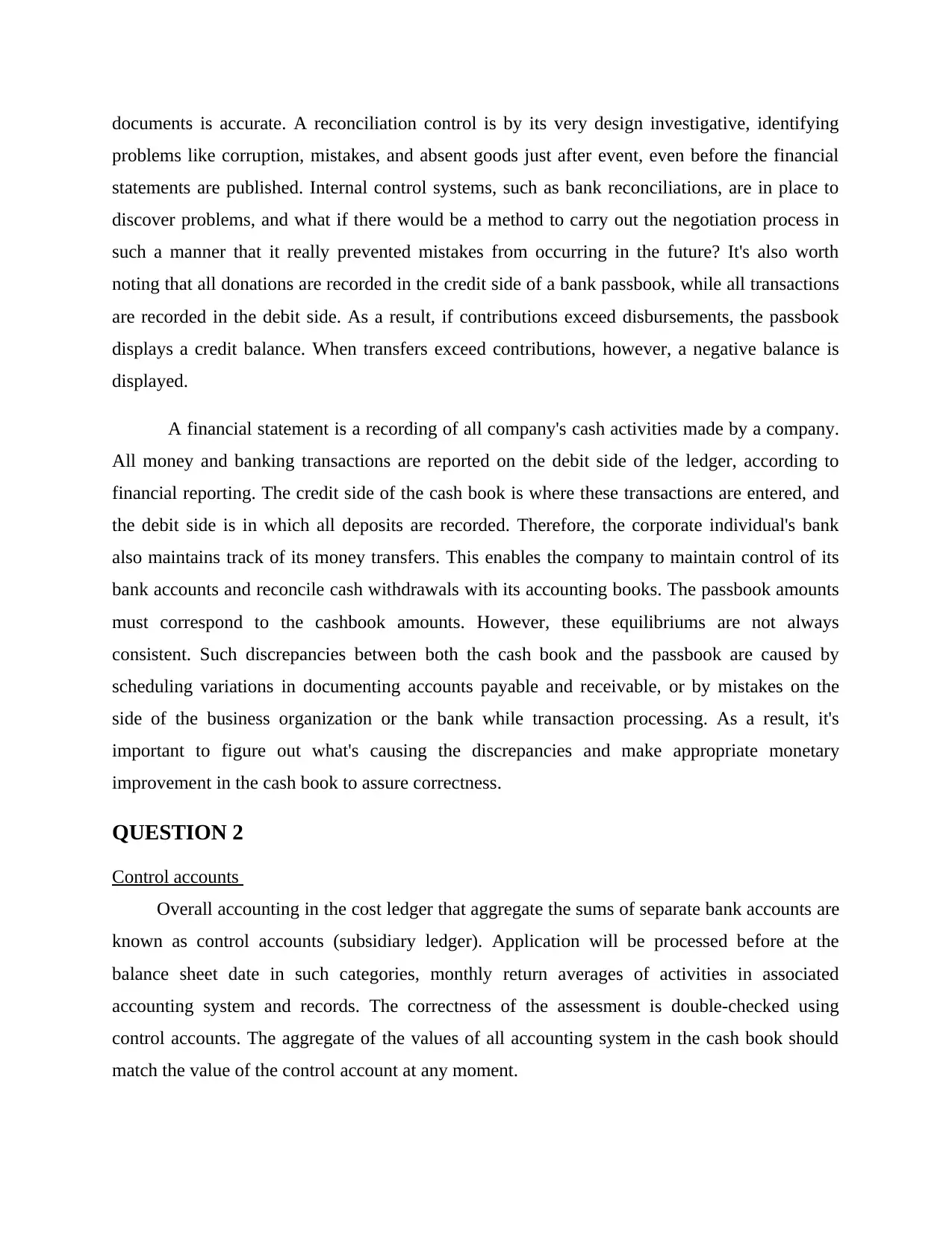
documents is accurate. A reconciliation control is by its very design investigative, identifying
problems like corruption, mistakes, and absent goods just after event, even before the financial
statements are published. Internal control systems, such as bank reconciliations, are in place to
discover problems, and what if there would be a method to carry out the negotiation process in
such a manner that it really prevented mistakes from occurring in the future? It's also worth
noting that all donations are recorded in the credit side of a bank passbook, while all transactions
are recorded in the debit side. As a result, if contributions exceed disbursements, the passbook
displays a credit balance. When transfers exceed contributions, however, a negative balance is
displayed.
A financial statement is a recording of all company's cash activities made by a company.
All money and banking transactions are reported on the debit side of the ledger, according to
financial reporting. The credit side of the cash book is where these transactions are entered, and
the debit side is in which all deposits are recorded. Therefore, the corporate individual's bank
also maintains track of its money transfers. This enables the company to maintain control of its
bank accounts and reconcile cash withdrawals with its accounting books. The passbook amounts
must correspond to the cashbook amounts. However, these equilibriums are not always
consistent. Such discrepancies between both the cash book and the passbook are caused by
scheduling variations in documenting accounts payable and receivable, or by mistakes on the
side of the business organization or the bank while transaction processing. As a result, it's
important to figure out what's causing the discrepancies and make appropriate monetary
improvement in the cash book to assure correctness.
QUESTION 2
Control accounts
Overall accounting in the cost ledger that aggregate the sums of separate bank accounts are
known as control accounts (subsidiary ledger). Application will be processed before at the
balance sheet date in such categories, monthly return averages of activities in associated
accounting system and records. The correctness of the assessment is double-checked using
control accounts. The aggregate of the values of all accounting system in the cash book should
match the value of the control account at any moment.
problems like corruption, mistakes, and absent goods just after event, even before the financial
statements are published. Internal control systems, such as bank reconciliations, are in place to
discover problems, and what if there would be a method to carry out the negotiation process in
such a manner that it really prevented mistakes from occurring in the future? It's also worth
noting that all donations are recorded in the credit side of a bank passbook, while all transactions
are recorded in the debit side. As a result, if contributions exceed disbursements, the passbook
displays a credit balance. When transfers exceed contributions, however, a negative balance is
displayed.
A financial statement is a recording of all company's cash activities made by a company.
All money and banking transactions are reported on the debit side of the ledger, according to
financial reporting. The credit side of the cash book is where these transactions are entered, and
the debit side is in which all deposits are recorded. Therefore, the corporate individual's bank
also maintains track of its money transfers. This enables the company to maintain control of its
bank accounts and reconcile cash withdrawals with its accounting books. The passbook amounts
must correspond to the cashbook amounts. However, these equilibriums are not always
consistent. Such discrepancies between both the cash book and the passbook are caused by
scheduling variations in documenting accounts payable and receivable, or by mistakes on the
side of the business organization or the bank while transaction processing. As a result, it's
important to figure out what's causing the discrepancies and make appropriate monetary
improvement in the cash book to assure correctness.
QUESTION 2
Control accounts
Overall accounting in the cost ledger that aggregate the sums of separate bank accounts are
known as control accounts (subsidiary ledger). Application will be processed before at the
balance sheet date in such categories, monthly return averages of activities in associated
accounting system and records. The correctness of the assessment is double-checked using
control accounts. The aggregate of the values of all accounting system in the cash book should
match the value of the control account at any moment.
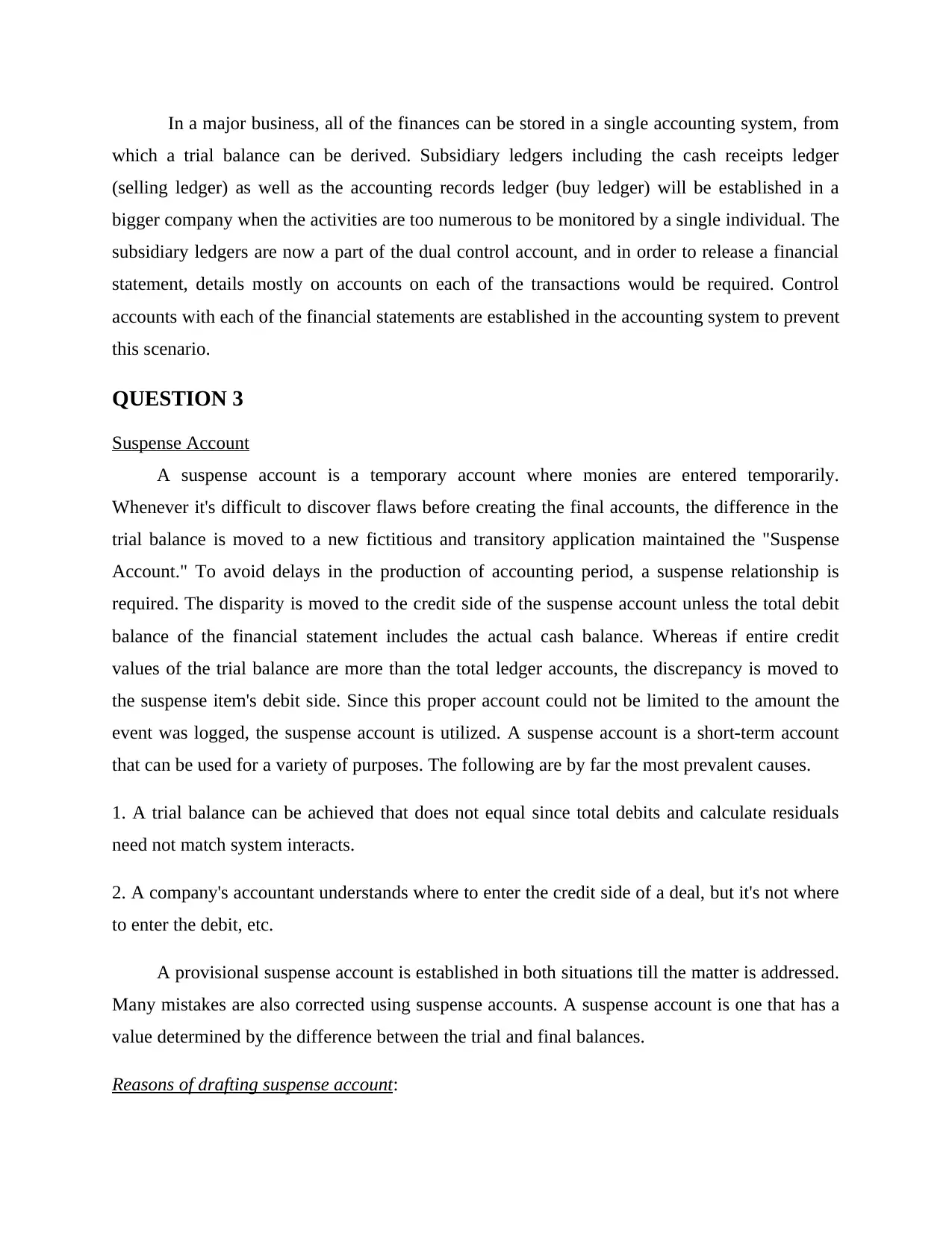
In a major business, all of the finances can be stored in a single accounting system, from
which a trial balance can be derived. Subsidiary ledgers including the cash receipts ledger
(selling ledger) as well as the accounting records ledger (buy ledger) will be established in a
bigger company when the activities are too numerous to be monitored by a single individual. The
subsidiary ledgers are now a part of the dual control account, and in order to release a financial
statement, details mostly on accounts on each of the transactions would be required. Control
accounts with each of the financial statements are established in the accounting system to prevent
this scenario.
QUESTION 3
Suspense Account
A suspense account is a temporary account where monies are entered temporarily.
Whenever it's difficult to discover flaws before creating the final accounts, the difference in the
trial balance is moved to a new fictitious and transitory application maintained the "Suspense
Account." To avoid delays in the production of accounting period, a suspense relationship is
required. The disparity is moved to the credit side of the suspense account unless the total debit
balance of the financial statement includes the actual cash balance. Whereas if entire credit
values of the trial balance are more than the total ledger accounts, the discrepancy is moved to
the suspense item's debit side. Since this proper account could not be limited to the amount the
event was logged, the suspense account is utilized. A suspense account is a short-term account
that can be used for a variety of purposes. The following are by far the most prevalent causes.
1. A trial balance can be achieved that does not equal since total debits and calculate residuals
need not match system interacts.
2. A company's accountant understands where to enter the credit side of a deal, but it's not where
to enter the debit, etc.
A provisional suspense account is established in both situations till the matter is addressed.
Many mistakes are also corrected using suspense accounts. A suspense account is one that has a
value determined by the difference between the trial and final balances.
Reasons of drafting suspense account:
which a trial balance can be derived. Subsidiary ledgers including the cash receipts ledger
(selling ledger) as well as the accounting records ledger (buy ledger) will be established in a
bigger company when the activities are too numerous to be monitored by a single individual. The
subsidiary ledgers are now a part of the dual control account, and in order to release a financial
statement, details mostly on accounts on each of the transactions would be required. Control
accounts with each of the financial statements are established in the accounting system to prevent
this scenario.
QUESTION 3
Suspense Account
A suspense account is a temporary account where monies are entered temporarily.
Whenever it's difficult to discover flaws before creating the final accounts, the difference in the
trial balance is moved to a new fictitious and transitory application maintained the "Suspense
Account." To avoid delays in the production of accounting period, a suspense relationship is
required. The disparity is moved to the credit side of the suspense account unless the total debit
balance of the financial statement includes the actual cash balance. Whereas if entire credit
values of the trial balance are more than the total ledger accounts, the discrepancy is moved to
the suspense item's debit side. Since this proper account could not be limited to the amount the
event was logged, the suspense account is utilized. A suspense account is a short-term account
that can be used for a variety of purposes. The following are by far the most prevalent causes.
1. A trial balance can be achieved that does not equal since total debits and calculate residuals
need not match system interacts.
2. A company's accountant understands where to enter the credit side of a deal, but it's not where
to enter the debit, etc.
A provisional suspense account is established in both situations till the matter is addressed.
Many mistakes are also corrected using suspense accounts. A suspense account is one that has a
value determined by the difference between the trial and final balances.
Reasons of drafting suspense account:
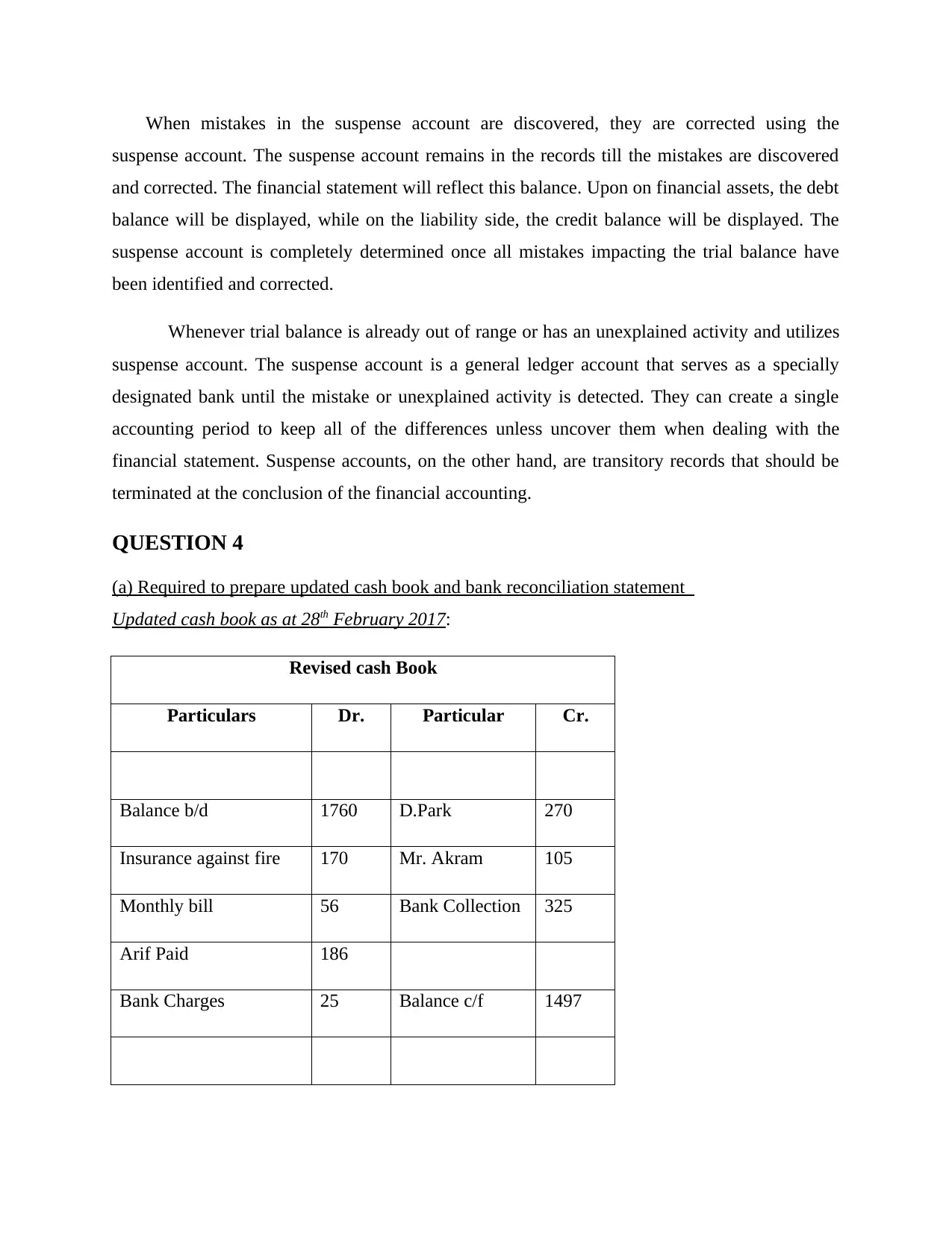
When mistakes in the suspense account are discovered, they are corrected using the
suspense account. The suspense account remains in the records till the mistakes are discovered
and corrected. The financial statement will reflect this balance. Upon on financial assets, the debt
balance will be displayed, while on the liability side, the credit balance will be displayed. The
suspense account is completely determined once all mistakes impacting the trial balance have
been identified and corrected.
Whenever trial balance is already out of range or has an unexplained activity and utilizes
suspense account. The suspense account is a general ledger account that serves as a specially
designated bank until the mistake or unexplained activity is detected. They can create a single
accounting period to keep all of the differences unless uncover them when dealing with the
financial statement. Suspense accounts, on the other hand, are transitory records that should be
terminated at the conclusion of the financial accounting.
QUESTION 4
(a) Required to prepare updated cash book and bank reconciliation statement
Updated cash book as at 28th February 2017:
Revised cash Book
Particulars Dr. Particular Cr.
Balance b/d 1760 D.Park 270
Insurance against fire 170 Mr. Akram 105
Monthly bill 56 Bank Collection 325
Arif Paid 186
Bank Charges 25 Balance c/f 1497
suspense account. The suspense account remains in the records till the mistakes are discovered
and corrected. The financial statement will reflect this balance. Upon on financial assets, the debt
balance will be displayed, while on the liability side, the credit balance will be displayed. The
suspense account is completely determined once all mistakes impacting the trial balance have
been identified and corrected.
Whenever trial balance is already out of range or has an unexplained activity and utilizes
suspense account. The suspense account is a general ledger account that serves as a specially
designated bank until the mistake or unexplained activity is detected. They can create a single
accounting period to keep all of the differences unless uncover them when dealing with the
financial statement. Suspense accounts, on the other hand, are transitory records that should be
terminated at the conclusion of the financial accounting.
QUESTION 4
(a) Required to prepare updated cash book and bank reconciliation statement
Updated cash book as at 28th February 2017:
Revised cash Book
Particulars Dr. Particular Cr.
Balance b/d 1760 D.Park 270
Insurance against fire 170 Mr. Akram 105
Monthly bill 56 Bank Collection 325
Arif Paid 186
Bank Charges 25 Balance c/f 1497
Secure Best Marks with AI Grader
Need help grading? Try our AI Grader for instant feedback on your assignments.
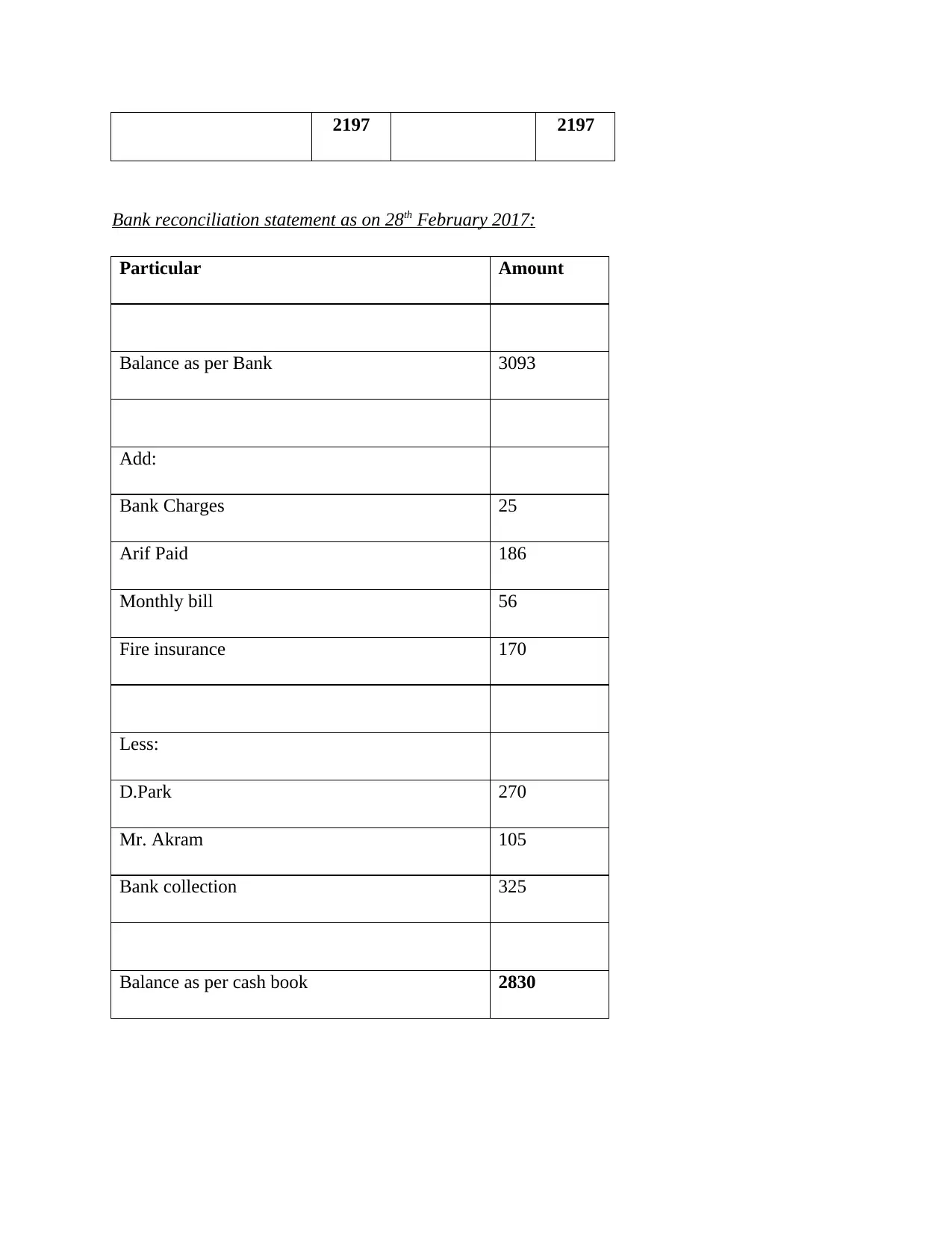
2197 2197
Bank reconciliation statement as on 28th February 2017:
Particular Amount
Balance as per Bank 3093
Add:
Bank Charges 25
Arif Paid 186
Monthly bill 56
Fire insurance 170
Less:
D.Park 270
Mr. Akram 105
Bank collection 325
Balance as per cash book 2830
Bank reconciliation statement as on 28th February 2017:
Particular Amount
Balance as per Bank 3093
Add:
Bank Charges 25
Arif Paid 186
Monthly bill 56
Fire insurance 170
Less:
D.Park 270
Mr. Akram 105
Bank collection 325
Balance as per cash book 2830
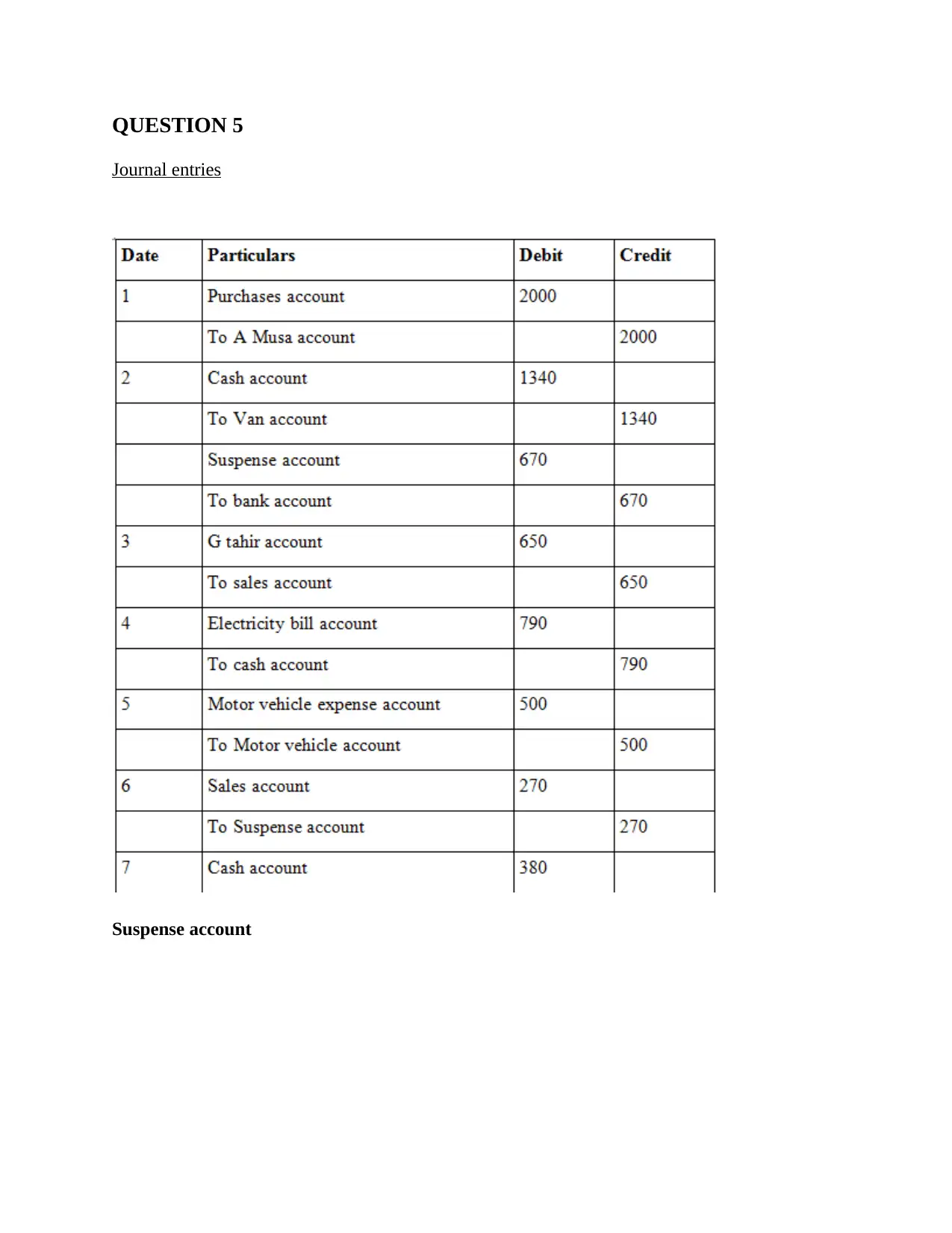
QUESTION 5
Journal entries
Suspense account
Journal entries
Suspense account
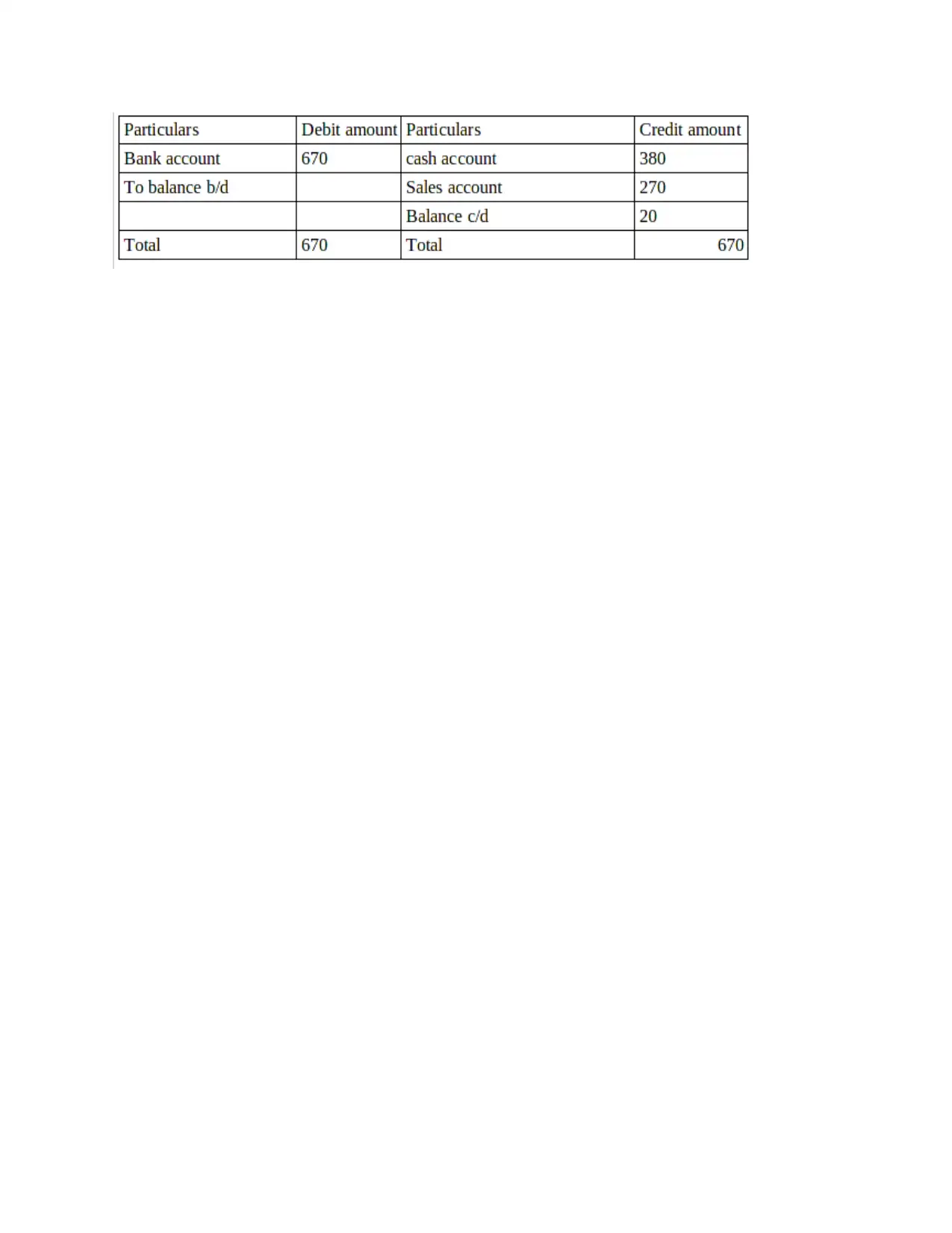
Paraphrase This Document
Need a fresh take? Get an instant paraphrase of this document with our AI Paraphraser
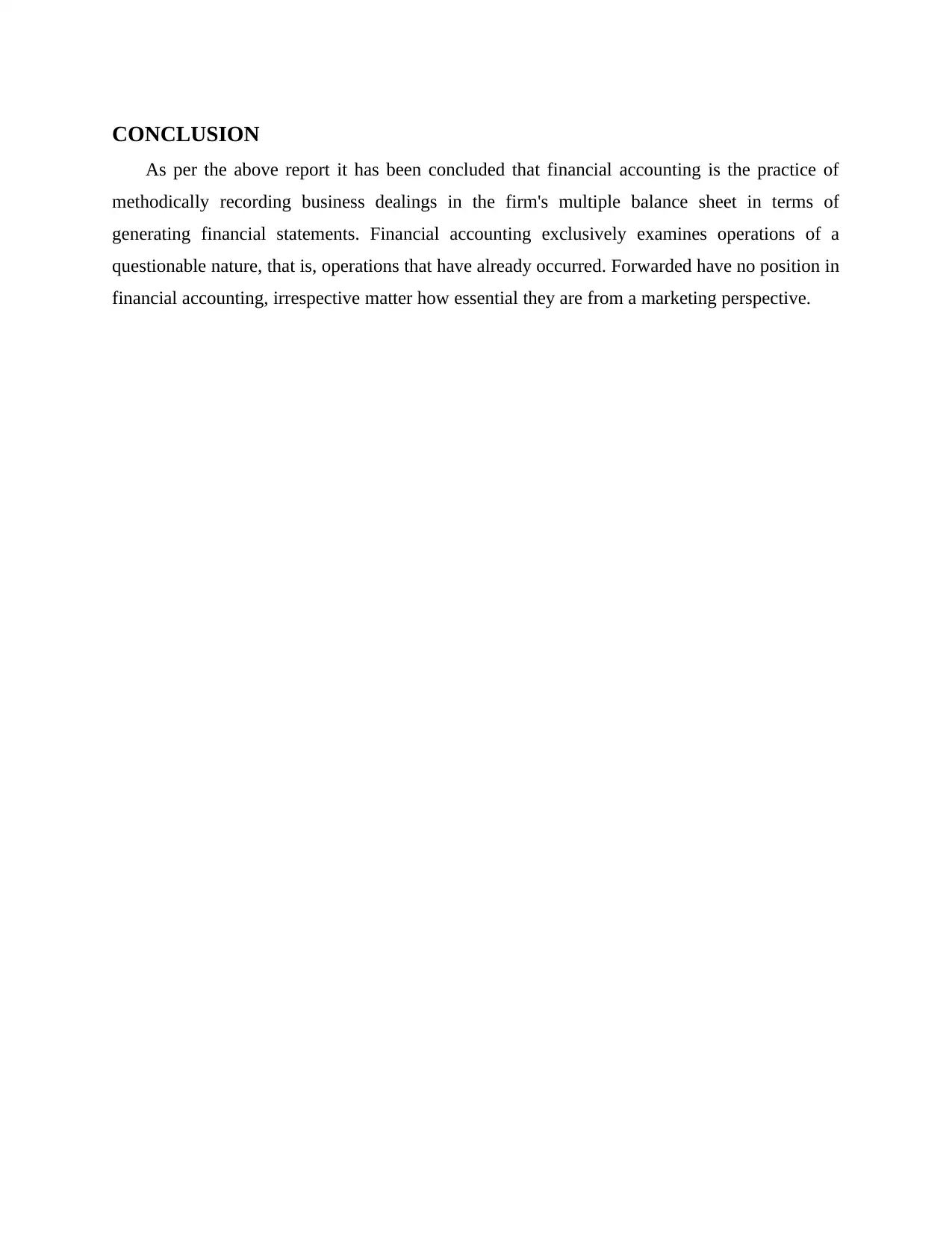
CONCLUSION
As per the above report it has been concluded that financial accounting is the practice of
methodically recording business dealings in the firm's multiple balance sheet in terms of
generating financial statements. Financial accounting exclusively examines operations of a
questionable nature, that is, operations that have already occurred. Forwarded have no position in
financial accounting, irrespective matter how essential they are from a marketing perspective.
As per the above report it has been concluded that financial accounting is the practice of
methodically recording business dealings in the firm's multiple balance sheet in terms of
generating financial statements. Financial accounting exclusively examines operations of a
questionable nature, that is, operations that have already occurred. Forwarded have no position in
financial accounting, irrespective matter how essential they are from a marketing perspective.
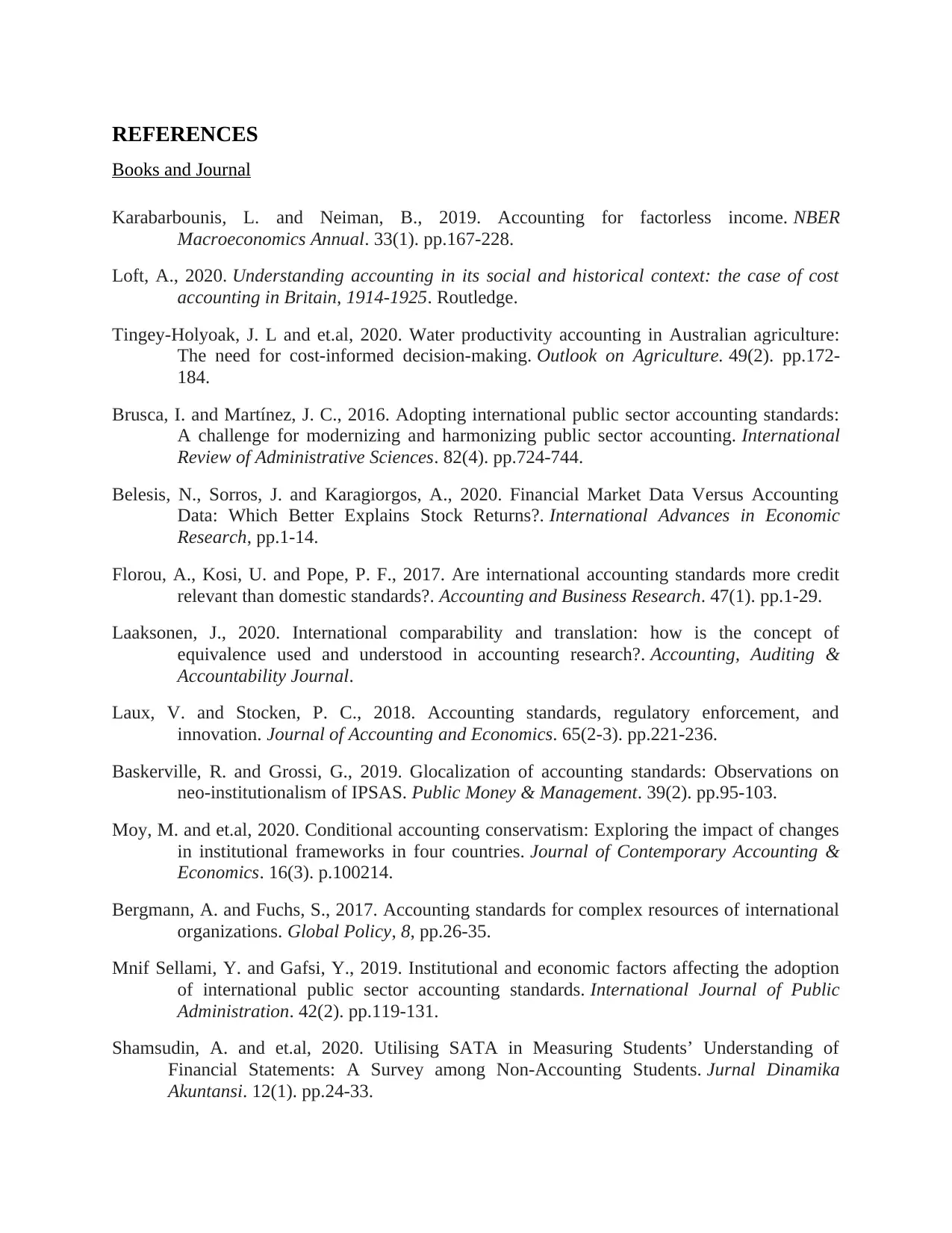
REFERENCES
Books and Journal
Karabarbounis, L. and Neiman, B., 2019. Accounting for factorless income. NBER
Macroeconomics Annual. 33(1). pp.167-228.
Loft, A., 2020. Understanding accounting in its social and historical context: the case of cost
accounting in Britain, 1914-1925. Routledge.
Tingey-Holyoak, J. L and et.al, 2020. Water productivity accounting in Australian agriculture:
The need for cost-informed decision-making. Outlook on Agriculture. 49(2). pp.172-
184.
Brusca, I. and Martínez, J. C., 2016. Adopting international public sector accounting standards:
A challenge for modernizing and harmonizing public sector accounting. International
Review of Administrative Sciences. 82(4). pp.724-744.
Belesis, N., Sorros, J. and Karagiorgos, A., 2020. Financial Market Data Versus Accounting
Data: Which Better Explains Stock Returns?. International Advances in Economic
Research, pp.1-14.
Florou, A., Kosi, U. and Pope, P. F., 2017. Are international accounting standards more credit
relevant than domestic standards?. Accounting and Business Research. 47(1). pp.1-29.
Laaksonen, J., 2020. International comparability and translation: how is the concept of
equivalence used and understood in accounting research?. Accounting, Auditing &
Accountability Journal.
Laux, V. and Stocken, P. C., 2018. Accounting standards, regulatory enforcement, and
innovation. Journal of Accounting and Economics. 65(2-3). pp.221-236.
Baskerville, R. and Grossi, G., 2019. Glocalization of accounting standards: Observations on
neo-institutionalism of IPSAS. Public Money & Management. 39(2). pp.95-103.
Moy, M. and et.al, 2020. Conditional accounting conservatism: Exploring the impact of changes
in institutional frameworks in four countries. Journal of Contemporary Accounting &
Economics. 16(3). p.100214.
Bergmann, A. and Fuchs, S., 2017. Accounting standards for complex resources of international
organizations. Global Policy, 8, pp.26-35.
Mnif Sellami, Y. and Gafsi, Y., 2019. Institutional and economic factors affecting the adoption
of international public sector accounting standards. International Journal of Public
Administration. 42(2). pp.119-131.
Shamsudin, A. and et.al, 2020. Utilising SATA in Measuring Students’ Understanding of
Financial Statements: A Survey among Non-Accounting Students. Jurnal Dinamika
Akuntansi. 12(1). pp.24-33.
Books and Journal
Karabarbounis, L. and Neiman, B., 2019. Accounting for factorless income. NBER
Macroeconomics Annual. 33(1). pp.167-228.
Loft, A., 2020. Understanding accounting in its social and historical context: the case of cost
accounting in Britain, 1914-1925. Routledge.
Tingey-Holyoak, J. L and et.al, 2020. Water productivity accounting in Australian agriculture:
The need for cost-informed decision-making. Outlook on Agriculture. 49(2). pp.172-
184.
Brusca, I. and Martínez, J. C., 2016. Adopting international public sector accounting standards:
A challenge for modernizing and harmonizing public sector accounting. International
Review of Administrative Sciences. 82(4). pp.724-744.
Belesis, N., Sorros, J. and Karagiorgos, A., 2020. Financial Market Data Versus Accounting
Data: Which Better Explains Stock Returns?. International Advances in Economic
Research, pp.1-14.
Florou, A., Kosi, U. and Pope, P. F., 2017. Are international accounting standards more credit
relevant than domestic standards?. Accounting and Business Research. 47(1). pp.1-29.
Laaksonen, J., 2020. International comparability and translation: how is the concept of
equivalence used and understood in accounting research?. Accounting, Auditing &
Accountability Journal.
Laux, V. and Stocken, P. C., 2018. Accounting standards, regulatory enforcement, and
innovation. Journal of Accounting and Economics. 65(2-3). pp.221-236.
Baskerville, R. and Grossi, G., 2019. Glocalization of accounting standards: Observations on
neo-institutionalism of IPSAS. Public Money & Management. 39(2). pp.95-103.
Moy, M. and et.al, 2020. Conditional accounting conservatism: Exploring the impact of changes
in institutional frameworks in four countries. Journal of Contemporary Accounting &
Economics. 16(3). p.100214.
Bergmann, A. and Fuchs, S., 2017. Accounting standards for complex resources of international
organizations. Global Policy, 8, pp.26-35.
Mnif Sellami, Y. and Gafsi, Y., 2019. Institutional and economic factors affecting the adoption
of international public sector accounting standards. International Journal of Public
Administration. 42(2). pp.119-131.
Shamsudin, A. and et.al, 2020. Utilising SATA in Measuring Students’ Understanding of
Financial Statements: A Survey among Non-Accounting Students. Jurnal Dinamika
Akuntansi. 12(1). pp.24-33.

AL-ANI, M.K. and TAWFIK, O. I., 2021. Effect of Intangible Assets on the Value Relevance of
Accounting Information: Evidence from Emerging Markets. The Journal of Asian
Finance, Economics, and Business, 8(2), pp.387-399.
Samanglangi, A., Lannai, D. and Rahim, S., 2020. Moderation of Corporate Good Governance
on Competence and Accounting Systems on Quality of Financial Statements. Point of
View Research Accounting and Auditing, 1(4), pp.150-160.
Accounting Information: Evidence from Emerging Markets. The Journal of Asian
Finance, Economics, and Business, 8(2), pp.387-399.
Samanglangi, A., Lannai, D. and Rahim, S., 2020. Moderation of Corporate Good Governance
on Competence and Accounting Systems on Quality of Financial Statements. Point of
View Research Accounting and Auditing, 1(4), pp.150-160.
1 out of 28
Related Documents
Your All-in-One AI-Powered Toolkit for Academic Success.
+13062052269
info@desklib.com
Available 24*7 on WhatsApp / Email
![[object Object]](/_next/static/media/star-bottom.7253800d.svg)
Unlock your academic potential
© 2024 | Zucol Services PVT LTD | All rights reserved.





